
How Much Does It Cost To Paint The Hull Of A Sailboat?

Last Updated by
Daniel Wade
June 15, 2022
Sailboats are designed to be exposed to the harshest of elements – water. As such, there is much more to painting the hull that choosing a color and slapping it on. A quality hull painting job will take time and have a range of cost involved. Hull painting is more than simply decorative, it is also protective.
Table of contents

Do I Need To Paint My Hull?
There are instances where the bottom painting isn’t necessary. If your boat is typically stored in a dry storage facility or on a trailer and only hits the water for a short time, you can opt not to paint. In these cases, your boat hull can be properly maintained with a heavy coat of wax and periodic cleanings. For most other boats that are docked in the water or see heavy off land use, bottom painting is essential.
Once you have made the choice to paint your hull, you must maintain it with periodic cleanings, paint removal and repainting with antifouling paint . This will help preserve the integrity of your hull intact and in proper operational condition.
What Is Antifouling Paint?
If your boat is usually stored in a dry storage facility or on a trailer and only hits the water for a short time, you can opt not to paint. This paint is applied all along the bottom of the hull up to the water line of the boat. This paint helps to protect the boat from various forms of water-based damage that can occur. Hull paint also prevents barnacles, weeds and other water-based life from attaching to the bottom of the sailboat.
Just like with regular paint there is a diverse range of brands, styles, and colors to choose from. Aside from these options, there are three types of antifouling paint; hard, hybrid, and ablative. The type you choose largely depends on the type of sailboat you have and your overall budget.
Hull Paint Types
Hard bottom paint is best for powerboats or other fast moving boats. It is a longlasting coating that is very hard and has a thick layer of biocide. The biocide layer wears away over time which allows the hull paint to last longer prior replacement. Once the biocide has been depleted, however, the hull must be repainted.
Ablative paint is well suited to casual boats and slow-moving sailboats. Unlike hard bottom paint, this type wears away directly over time. As the paint wears away while moving through the water, it releases more biocides. Many boaters call this paint self-polishing. As the paint wears thin on the hull, it will need to be replaced. Since there is less paint to remove, repainting the hull is easier and tends to be more affordable.
Hybrid paint is exactly what the name implies. It is a mix of both hard and ablative paint and can be used on all types of sailboats.
How Much Does It Cost to Paint a Sailboat?
Now that you recognize some of the basics about the need for hull painting as well as the main types of paint available, we can cover the cost. When it comes to hull painting, you can hire a professional or you can do it yourself. Just like most hobby projects, compared to hiring a professional you will save money. On the other hand, having your hull professionally painted will cost you more, but it will take less time and come with a guarantee.
DIY Hull Painting
A certain peace comes from caring for your sailboat with your own hands. If you choose to take on the task of painting your hull on your own, make sure to plan adequately and give yourself plenty of time to get the job executed properly. Though you can expect to pay less when you do it yourself, the cost still will vary widely. The main expense depends on the amount of paint you need and the type of paint you choose for your hull.
Hull paint is sold in one-gallon containers and can range from $20 - $200 per gallon. The price range depends on primarily the brand and style of hull paint. Aside from the paint, you will also need to budget for painting supplies such as;
- Paintbrushes
- Drop Cloths
- Paint trays
- Masking tape
- Breathing mask
The size of your boat will determine how much product you need, and each brand list the amount needed per linear foot on the can. The majority of ablative hull paints will require two coats and modified epoxy hull paints only require one coat. Make sure to keep these in mind when calculating your cost.
- Single coat paints for boats that are between 20 – 35 feet will need 1 ½ gallon of paint.
- Double coat paints for boats that are between 20 – 35 feet will need 3 gallons of paint.
- Single coat paints for boats that are between 36 – 35 feet will need 3 ½ gallons of paint.
- Double coat paints for boats that are between 36 – 51 feet will need 6 gallons of paint.
- Single coat paints for boats that are between 53 – 63 feet will need 4 ½ gallons of paint.
- Double coat paints for boats that are between 53 – 63 feet will need 9 gallons of paint.
Professional Hull Painting
Hull painting by a professional starts off with a base cost that is determined by the size of your sailboat. As of 2019, the average cost per linear ft falls around $25 for basic selections which can range up to $125 per linear foot for premium selections. Boats that need more work or additional repairs may incur an additional cost.
Customarily, professionals will charge a moderately lower rate for larger boats over smaller ones. There are also cost involved with where your boat will be painted. Sailboats that must be blocked, stored or transported prior to painting will incur heftier fees than those on a trailer or stored on a personal slip. Older boats that have damage to the hull or other defects will need to be repaired prior to painting the hull which can also increase the cost. Virgin hulls, basically ones that have never been painted before will cost less to complete since there will be no need to have a paint removal service completed.
Depending on your boat size and your exact location, you can expect to pay the following estimated rates for basic hull painting & premium hull painting.
- $25.00 per linear ft. – 29′ sailboat + $155.00 for premium upgrades
- $29.00 per linear ft. – 30′ to 36′ sailboat + $190.00 for premium upgrades
- $34.00 per linear ft. – 37′ to 43′ sailboat + $250.00 for premium upgrades
- $38.00 per linear ft.. – 44′ to 49′ sailboat + $330.00 for premium upgrades
- $43.00 per linear ft. – 50′ to 54′ sailboat + $400.00 for premium upgrades
- $49.00 per linear ft. – 55′ to 59′ sailboat + $490.00 for premium upgrades
- $56.00 per linear ft. – 60′ and larger sailboats + $555.00 for premium upgrades
The Bottom Line
When it comes down to it, the cost of painting your sailboat hull is neither excessive or unmanageable. You have a range of options that will allow you to choose the best paint and finish for your hull that falls within your personal budget. Caring for your hull will ensure you get the most use out of your sailboat for years to come. Proper hull maintenance will prevent the growth of waterborne pests such as slime and barnacles while also giving your boat a sophisticated appearance. We wish you smooth sailing ahead and hope to see you again soon!
Related Articles
I've personally had thousands of questions about sailing and sailboats over the years. As I learn and experience sailing, and the community, I share the answers that work and make sense to me, here on Life of Sailing.
by this author
Repairs and Maintenance
Financial and Budgeting
Most Recent

What Does "Sailing By The Lee" Mean?
October 3, 2023

The Best Sailing Schools And Programs: Reviews & Ratings
September 26, 2023
Important Legal Info
Lifeofsailing.com is a participant in the Amazon Services LLC Associates Program, an affiliate advertising program designed to provide a means for sites to earn advertising fees by advertising and linking to Amazon. This site also participates in other affiliate programs and is compensated for referring traffic and business to these companies.
Similar Posts

Best Bluewater Sailboats Under $50K
December 28, 2023

How To Choose The Right Sailing Instructor
August 16, 2023

Cost To Dock A Sailboat
May 17, 2023
Popular Posts

Best Liveaboard Catamaran Sailboats

Can a Novice Sail Around the World?
Elizabeth O'Malley

4 Best Electric Outboard Motors

How Long Did It Take The Vikings To Sail To England?

10 Best Sailboat Brands (And Why)
December 20, 2023

7 Best Places To Liveaboard A Sailboat
Get the best sailing content.
Top Rated Posts
Lifeofsailing.com is a participant in the Amazon Services LLC Associates Program, an affiliate advertising program designed to provide a means for sites to earn advertising fees by advertising and linking to Amazon. This site also participates in other affiliate programs and is compensated for referring traffic and business to these companies. (866) 342-SAIL
© 2024 Life of Sailing Email: [email protected] Address: 11816 Inwood Rd #3024 Dallas, TX 75244 Disclaimer Privacy Policy
How Much Does It Cost to Paint a Boat? (Price Chart)
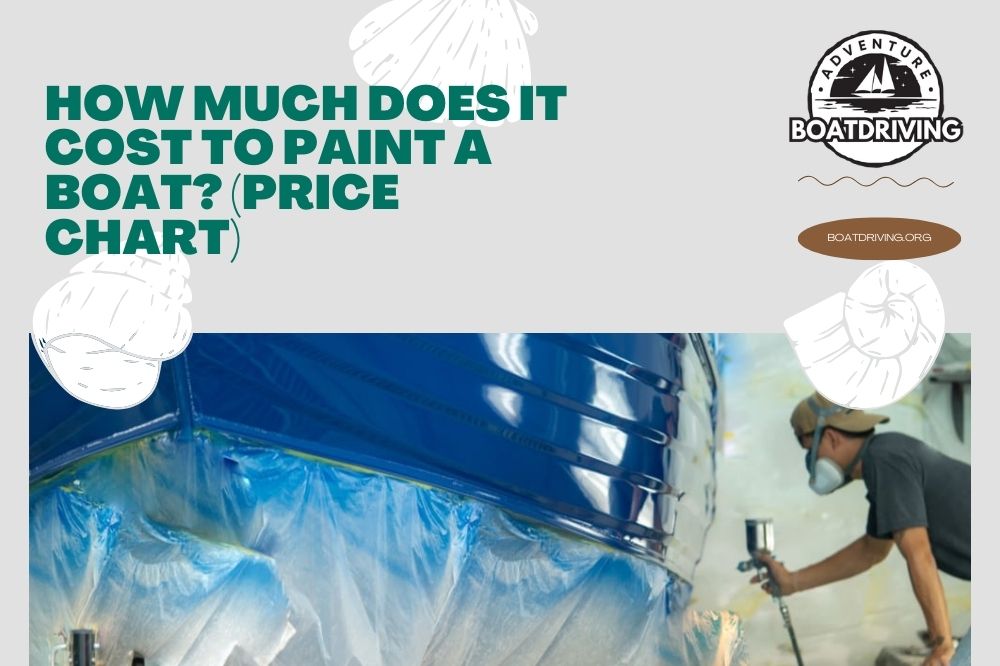
One of the most vital questions boat owners have is how much does it cost to paint a boat. It depends on numerous factors and can be $2 to even $400 per linear foot. So, painting may cost you a couple of hundred dollars to at least $5,000.
As you can see, the gap between those two values is vast, so you should check all relevant factors before starting with work. The first thing to decide is hiring a professional or organizing a DIY project. Then, overall costs will vary depending on the paint type and boat size. Let’s take a look.
Table of Contents
Why Should You Paint Your Boat?
Boat painting costs by types, what does affect the boat painting cost.
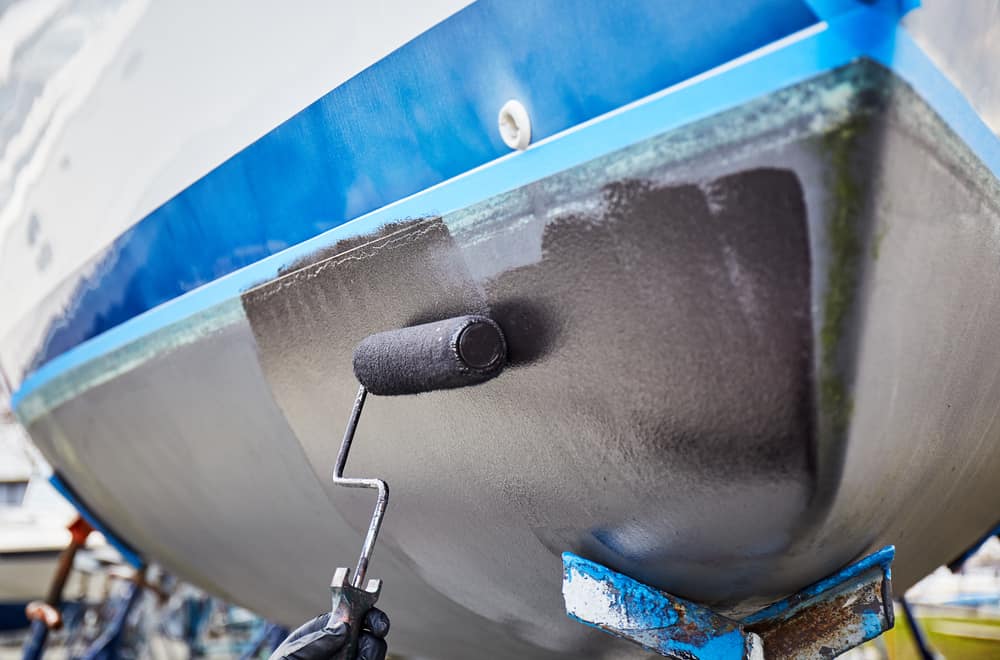
Whether you have a boat made of fiberglass , wood, or aluminum, its painting is highly beneficial and can prolong its life. It will also increase the vessel value, which is crucial if you plan to sell it in the future.
Plus, specialized paint will protect it from water damage and prevent water plants from sticking. Be prepared that this action is not easy and requires excellent preparation and a lot of hard work. It is estimated that about 75% of the process is preparation work if you want to get the desired boat look.
Before starting, you should determine if you need to paint the whole boat or only its parts. That will directly affect the amount of work and price.
Bottom (antifouling) painting
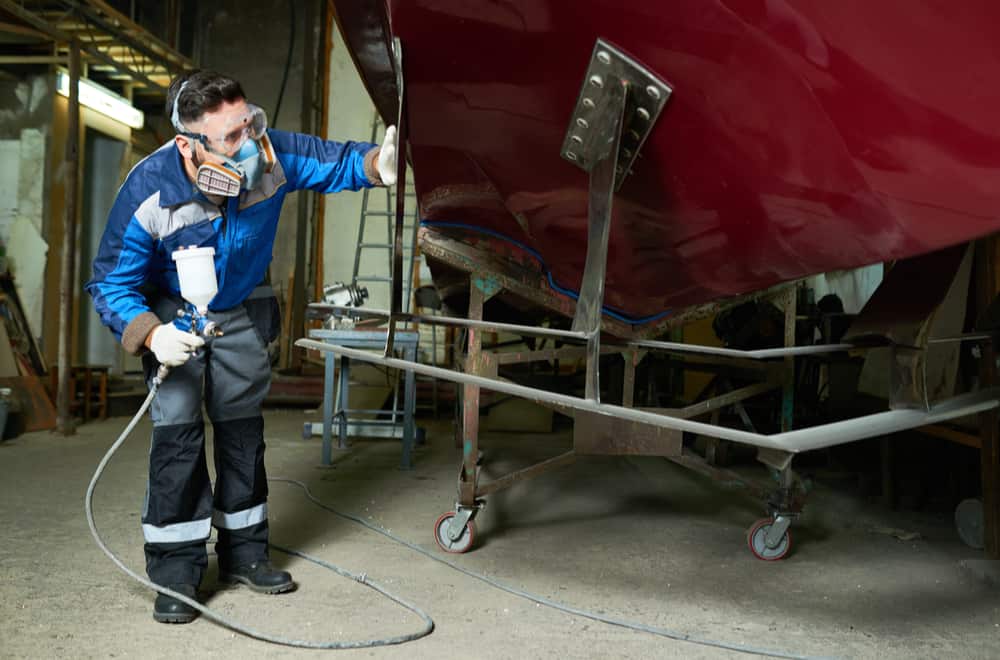
This painting type includes painting the vessel part below the water level. Most owners who use their boat regularly consider it unnecessary, but it is beneficial for vessels kept mainly on the dock.
Its primary purpose is to protect the hull from damage caused by barnacles and weeds. Remember that it is often unnecessary, but once you paint the boat bottom, it is necessary to regularly clean and re-paint it.
The first thing to do is to pick out the appropriate paint:
Ablative bottom paint – This self-polishing paint is an excellent option for slow-moving boats. It gradually wears away and releases biocides while sailing, making future re-painting effortless.
Hard bottom paint – This durable hard coating is an option for powerboats and other fast boats. The downside is that you need to remove it before re-painting your vessel.
Hybrid (semi-hard ablative) paint – This paint type is suitable for most boats and provides a smooth and hard surface resistant to buildup.
Besides the paint type, overall costs for professional bottom painting will depend on:
- Boat condition
- Way of keeping (in the water, a yard, or on a trailer )
If you decide on a DYI project, you will spend approximately $100 to $500 to complete painting your boat bottom.
Professional service implies the price of $15 to $100 per linear foot, but the average cost is about $20 to $45 per linear foot. That means you should set aside $300 to $800 for an average boat of 20 feet (6 m).
However, that number can reach $2,000, sometimes even $5,000, depending on the boat size, the company you choose, paint quality, and possible bottom damage.
Topside painting
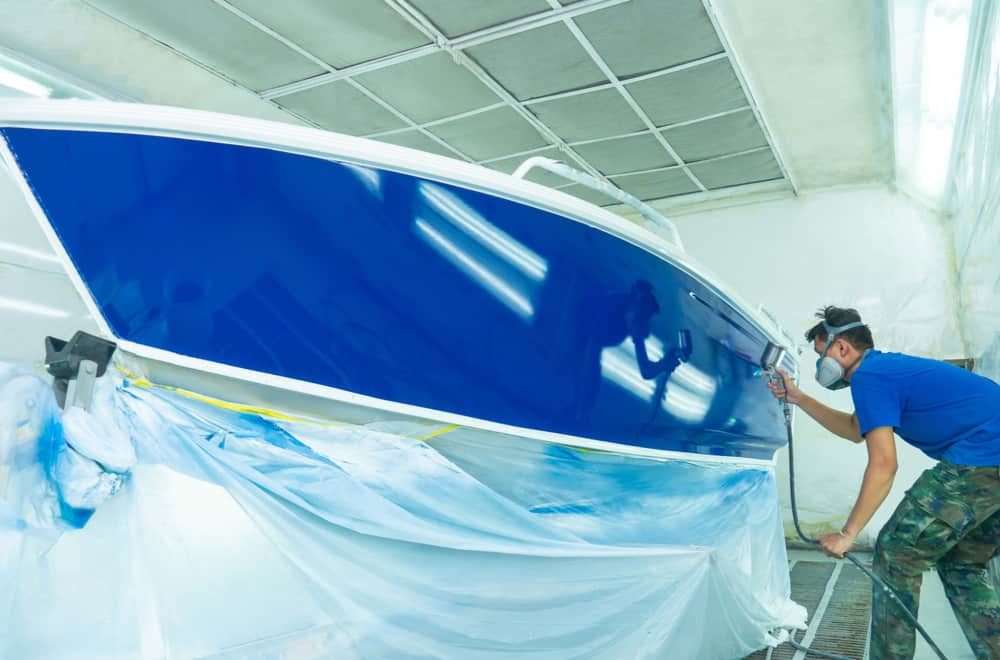
Topside painting has an aesthetic purpose and will protect the boat from water and sunlight exposure. The process includes boat body re-pairs, surface preparation, and primer application.
Before starting, you should determine if you need to paint the whole boat or only its parts, including:
- The interior
That will directly affect the amount of work and price . Remember that painting the boat topside requires a different procedure and paint type than bottom painting.
Overall topside boat painting costs can significantly vary, depending on:
You can choose among three topside paint types:
Alkyd enamel – This oil-based, low gloss paint is easy-to-apply and cheap but has poor color retention and low gloss.
One-part polyurethane – This popular, cheap, and easy-to-apply option is perfect for DIY topside painting.
Two-part polyurethane – This hard, durable, and expensive high-gloss topside paint type is tricky to apply, so it is better to hire a professional to work with it.
Additionally, you should pay more for a sizable boat and plan more money if your vessel is damaged.
The average DIY topside painting price is approximately $350. In this case, you should calculate paint price and add costs for prep materials, like:
- Paintbrush and paint trays
- Masking tape and sandpaper
The professional topside painting will cost you $100 to $400 per linear foot. However, the average price is often $200 to $250 per linear foot for an undamaged boat, particularly when choosing low-quality paint.
For instance, you need to set aside $4,000 to $5,000 for an average 20 feet (6 m) long vessel on average. However, the price range is from $2,000 to $8,000.
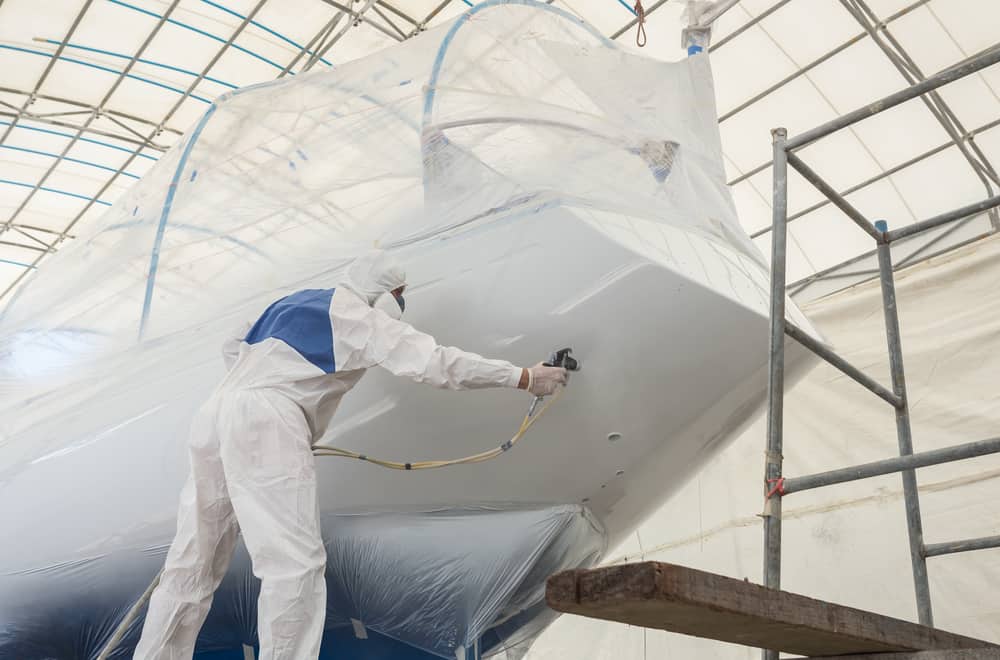
Bids you get for painting your boat can significantly vary, but you always need to pay for the same things:
Since different boat parts require specific paints , their price will vary from $100 to $300 per 1 gallon (3.8 l). So, you will get an approximate price after estimating your boat length and how much paint you need per 1 foot (0.3 m).
Remember that most modified epoxy hull paints quire only one coat, but you should calculate two coats when using ablative hull paints. Most hull paints will cost you $20 to $200 per gallon, but the final price will depend on the paint brand and painting style you choose.
Professional hull painting price primarily depends on your boat size and is typical $25 to $125 per linear foot. Remember that this price can be higher when your vessel requires additional re-pairing and more work, while a first painting of the new boat will be charged lower.
As you can expect, boat size will directly affect overall costs. However, professionals sometimes charge a higher rate per linear foot for small boats over bigger ones. The price will also depend on the place where you plan a painting. It is always more pricey when transportation is necessary.
Remember that marina quotes typically include all charges, except when later found problems require extra work. Plus, most professionals will quote for painting based on estimated rather than exact hours necessary to finish the job. They will let you know if some unexpected costs appear.
Consumables
You should also pay for some tools and supplies, such as:
- Rubber gloves, goggles, and protective masks
- Tyvek suits
- Paint stirrers
Always check whether the bill includes those things to prevent unpleasant surprises that count hundreds of dollars. Also, you will pay for everything bought, not only for what they have used.
For instance, you need to pay for an entire masking tape roll, although only a small piece has been used.
Extra costs
Paint stripping – As I have already mentioned, some paints will require stripping before applying a new paint layer, so you need to pay for this work. However, it will make it easier to notice any existing damage and allow better prime.
Customization – Simply said, you need to pay extra if you prefer to give your boat a unique and distinctive look. It is possible to add an application, your initials, or the company logo on the hull.
Professionals typically calculate this service cost by linear feet, so you should count on $100 and $400 for the customizing topside painting and approximately $15 to $100 for the bottom painting.
Insurance and disposal and environmental charges
Professionals will invariably include insurance costs in the final bill. Plus, many states charge environmental charges and marina fees because of paint’s inherent toxicity. So, you should also pay for that, regardless of whether it is a flat fee or a bill percentage. Finally, you need to add disposal charges to overall costs.
Sailing exposes your boat to numerous outdoor elements , making protective painting crucial for prolonging its life. Plus, a freshly coated boat will look more representative, and its price will be higher once you decide to sell it.
The planned budget will depend on the boat size, paint type, and the way of finishing that task. The DIY project will be more affordable, but hiring professionals often means a more appealing boat look.
Related posts:
- 5 Types of Marine Heads: Which is Better?
- Kelly Blue Book Boat Values (3 Types)
- 6 Tips to Choose the Correct Boat Propeller
- 10 Best Bay Boats Under 30k
Leave a Comment Cancel reply
Save my name, email, and website in this browser for the next time I comment.

How Much Does It Cost to Paint the Hull of a Sailboat? A Comprehensive Guide to Factors Affecting the Cost and Tips for Saving Money

If you’re a sailor, you know that maintaining the hull of your sailboat is crucial to keeping it seaworthy and looking its best. One of the most important parts of this maintenance is painting the hull, which not only protects the boat from the harsh elements but also gives it a fresh new look. However, before you dive into this project, it’s important to consider the cost of painting the hull of your sailboat. In this blog post, we’ll explore the factors that affect the cost of painting a sailboat hull, and provide you with some estimates so you can make an informed decision.
Read Also: Navigating the High Seas
Table of Contents
Factors that Affect the Cost of Painting a Sailboat Hull
- Size of the Boat – The size of your sailboat is a major factor that affects the cost of painting its hull. Generally, the larger the boat, the more expensive it is to paint. This is because larger boats require more paint, as well as more labor and time to complete the job. A smaller sailboat may only cost a few hundred dollars to paint, while a larger boat could cost several thousand dollars.
- Condition of the Hull – The condition of the hull is another factor that can affect the cost of painting your sailboat. If your hull is in good condition and only requires a touch-up, the cost will be lower. However, if your hull requires extensive repairs or sanding, this will increase the cost of the project.
- Type of Paint Used – The type of paint used is another important factor that affects the cost of painting a sailboat hull. There are different types of paint available, including antifouling paint, which is designed to prevent marine growth on the hull, and topside paint, which is used for cosmetic purposes. Antifouling paint tends to be more expensive, but it is a necessary expense if you plan on keeping your boat in the water for an extended period.
- Labor Costs – The cost of labor is another significant factor that affects the cost of painting a sailboat hull. The cost of labor will vary depending on where you are located and the experience of the painter. You should always get multiple quotes from different painters to ensure that you are getting a fair price.
- DIY or Professional – Finally, the decision to paint your sailboat hull yourself or hire a professional will affect the cost of the project. If you have experience with painting and the necessary equipment, you may be able to save money by doing it yourself. However, if you lack experience, it may be more cost-effective to hire a professional.
Estimates for Painting a Sailboat Hull
Now that we’ve discussed the factors that affect the cost of painting a sailboat hull, let’s provide you with some estimates. These estimates are for a basic paint job and do not include any repairs or extensive preparation work.
For a small sailboat (under 20 feet), you can expect to pay between $500 and $1,000 for a basic paint job.
For a medium-sized sailboat (between 20 and 30 feet), you can expect to pay between $1,500 and $3,500 for a basic paint job.
For a large sailboat (over 30 feet), you can expect to pay between $3,500 and $10,000 for a basic paint job.
Of course, these are just estimates, and the final cost will depend on the factors we discussed earlier. It’s always a good idea to get multiple quotes from different painters before making a decision.
Read Also: Some Previous posts covered the excitement of sailing in Utah , California , Rhode Island , Portland , Hawaii , as well as the cheapest places where to live on a boat.
Tips for Saving Money When Painting Your Sailboat Hull
If you’re looking to save money when painting your sailboat hull, here are some tips:
- Do some of the work yourself: You may be able to save money by doing some of the prep work yourself, such as sanding or more
- Shop around for quotes: It’s always a good idea to get multiple quotes from different painters to ensure that you are getting a fair price.
- Choose a less expensive paint: While high-quality paint may be more durable and longer-lasting, it can also be more expensive. If you’re on a tight budget, you may want to consider a less expensive paint that still offers adequate protection.
- Schedule the job during the off-season: Many boatyards and painters offer discounts during the off-season, which can be a great way to save money.
- Consider a DIY approach: If you have the necessary equipment and experience, you may be able to save money by painting your sailboat hull yourself.
What’s the best time to Paint the Hull of a Sailboat
The best time to paint the hull of a sailboat depends on a few factors, including the climate in your area, the type of paint you plan to use, and your schedule. In general, the best time to paint a sailboat hull is during the off-season or when the weather is dry and mild. This allows the paint to dry properly and minimizes the risk of rain or other weather conditions interfering with the painting process. However, if you plan to use an antifouling paint, you may need to schedule the job closer to when you plan to launch your boat, as these types of paints require contact with water to activate. It’s always a good idea to consult with a professional painter or the manufacturer of the paint you plan to use to determine the best time to paint your sailboat hull.
Read Also: Sailing Destinations from San Diego .
Table showing the best time to paint a boat per state in USA
Here’s a table indicating the best time to paint a boat in each state in the USA:
Note: The best time to paint a boat in each state may vary depending on the specific weather conditions and other factors in that region. It’s always a good idea to consult with a professional painter or the manufacturer of the paint you plan to use to determine the best time to paint your boat in your particular area.
Read Also: Best Sailing Destinations
In Conclusion
Painting the hull of your sailboat is an essential part of maintaining its integrity and appearance. While the cost of this project can vary depending on the size of your boat, the condition of the hull, the type of paint used, the labor costs, and whether you choose to do it yourself or hire a professional, it’s always a good idea to get multiple quotes and consider ways to save money without sacrificing quality.
Ultimately, the cost of painting your sailboat hull is an investment in the longevity and beauty of your boat, and it’s important to choose a reputable and experienced painter who can deliver a high-quality finish that will protect your boat for years to come.
Read Also: Kayaking and Paddle Boarding in Newport, Rhode Island
Steven T. Anderson
Steven Taylor Anderson is an experienced sailor and author who writes for sailingbetter.com. He has been sailing for over 20 years across the USA and has taken several courses to improve his skills. He has also navigated throughout the world on various boats and yachts. His passion for sailing and knowledge of the sport shines through in his writing, making him a respected authority on the subject.
Recent Posts
Lagoon vs Leopard Catamaran: Which Sailboat Is Right for You?
Introduction When it comes to cruising on the open waters, catamarans have gained immense popularity for their stability, space, and comfort. Two of the leading catamaran manufacturers, Lagoon and...
How to Determine Sailboat Weight: A Comprehensive Guide
Introduction Sailing is a thrilling and adventurous activity that has captivated humans for centuries. Whether you are a seasoned sailor or a novice looking to set sail for the first time,...

How Much Does It Cost to Paint a Boat? A Comprehensive Guide to Boat Painting Costs
Painting a boat is an essential part of boat maintenance that helps to protect it from the harsh marine environment. However, the cost of painting a boat can vary depending on several factors, including the size of the boat, the quality of the paint, and whether you hire a professional or do it yourself.
According to recent estimates, the cost to paint a boat can range from a few hundred dollars to several thousand dollars. A top-to-bottom guide on Best Boat Report suggests that painting a boat may cost between $400 and $10,000, depending on the size of the boat, the quality of the paint, and whether you hire a professional or go the DIY route . Other factors such as hauling and storage fees may also affect this cost.
If you’re considering painting your boat, it’s essential to understand the factors that affect the cost and how to get the best value for your money. This article will explore the cost of painting a boat in more detail and provide tips on how to save money while getting a quality paint job.

Understanding the Basics of Boat Painting
Painting a boat is an essential part of boat maintenance that helps to protect the vessel from the harsh marine environment. It also enhances the boat’s appearance, making it look new and attractive. However, the cost of painting a boat can vary significantly depending on several factors, including the size of the boat, the type of paint used, and whether a professional painter is hired or not.
Types of Boat Painting
There are two types of boat painting: topside painting and bottom painting. Topside painting refers to painting the exterior of the boat above the waterline, including the hull, deck, and superstructure. Bottom painting, on the other hand, involves painting the underwater part of the boat below the waterline, including the hull and keel.
Factors that Affect the Cost of Boat Painting
Several factors can affect the cost of painting a boat, including:
- Boat size: The larger the boat, the more paint and labor are required, which increases the cost of painting.
- Type of paint: High-quality marine paints are more expensive than standard paints, but they offer better protection against the marine environment.
- Professional vs. DIY: Hiring a professional to paint the boat will cost more than doing it yourself, but it ensures a high-quality finish and saves time and effort.
Cost of Boat Painting
The cost of painting a boat can vary widely depending on the factors mentioned above. According to Best Boat Report , the cost of painting a boat can range from $400 to $10,000 or more. This cost includes the cost of paint, labor, and other expenses such as hauling and storage fees.
Boat owners who choose to paint their boats themselves can save money on labor costs but should be prepared to invest time and effort into the project. According to Pro Paint Corner , the average cost of painting the bottom of a boat ranges from $300 to $2,000, depending on the quality of the paint and the size of the boat.
In conclusion, painting a boat is an essential part of boat maintenance that helps to protect the vessel and enhance its appearance. The cost of painting a boat can vary widely depending on several factors, including the size of the boat, the type of paint used, and whether a professional painter is hired or not. Boat owners should carefully consider these factors before embarking on a boat painting project.
Determining the Cost to Paint a Boat
Determining the cost to paint a boat can be a challenging task as it depends on various factors. The size of the boat, the quality of the paint, and whether you hire professionals or do it yourself are some of the key factors that can affect the cost.
According to Best Boat Report , painting a boat may cost anywhere between $400 and $10,000. The cost varies depending on the size of the boat, the type of paint used, and the labor cost.
The cost of painting a boat also depends on the type of painting required. For instance, painting the bottom of the boat costs more than painting the topside. The average cost of painting the bottom of a boat ranges from $300 to $2000, depending on the quality of the paint and the size of the boat. The quality of the paint used for the bottom is essential to withstand saltwater and other elements.
Another factor that can affect the cost of painting a boat is whether you hire professionals or do it yourself. Hiring professionals can be expensive, but it ensures that the job is done correctly. On the other hand, painting the boat yourself can be cost-effective, but it requires a lot of time and effort.
It is essential to get quotes from multiple companies before deciding on a particular one. This will help you compare prices and choose the one that fits your budget. Additionally, it is crucial to factor in the cost of hauling and storage fees when determining the overall cost of painting a boat.
In conclusion, determining the cost to paint a boat depends on various factors such as the size of the boat, type of paint, and whether you hire professionals or do it yourself. It is essential to get multiple quotes and factor in additional costs such as hauling and storage fees to determine the overall cost.
Factors Influencing the Cost of Boat Painting
The cost of painting a boat can vary depending on several factors. Here are some of the factors that can influence the cost of boat painting:
Boat Size and Condition
The size and condition of the boat are significant factors that can determine the cost of painting. Larger boats will generally require more paint, more labor, and more time, which can increase the cost. Additionally, if the boat is in poor condition, it may require more preparation work, such as sanding and filling, which can also increase the cost of painting.
Different types of boats require different types of paint and preparation work. For example, fiberglass boats require a different type of paint than aluminum boats . Sailboats may require more detailed painting work than powerboats, which can also affect the cost.
Quality of Paint
The quality of paint used can also affect the cost of boat painting. Higher quality paint may cost more, but it can also last longer and provide better protection against the elements. Cheaper paint may require more frequent repainting, which can add to the overall cost in the long run.
Different types of paint can also affect the cost of boat painting. Two-part polyurethane paint is a popular choice for boat painting, but it can be more expensive than other types of paint. However, it can also provide better protection and a more durable finish.
Environmental Charges and Disposal Charges
Environmental charges and disposal charges can also affect the cost of boat painting. Some boatyards may charge extra fees for environmental disposal of paint and other materials. It’s essential to find out about these fees before starting the painting process to avoid any surprises.
Overall, the cost of painting a boat can vary significantly depending on several factors. It’s essential to consider all of these factors before starting the painting process to get an accurate estimate of the cost.
Materials and Supplies Required
Painting a boat requires several materials and supplies, including sandpaper, masking tape, primer, paintbrushes, spray guns, paint trays, prep materials, a tape measure, and respirators. The cost of these materials and supplies varies depending on the boat’s size and the quality of the materials.
Sandpaper is essential for preparing the boat’s surface for painting. It is used to remove old paint, rust, and other debris from the boat’s surface. The cost of sandpaper depends on its grit size and the number of sheets needed to complete the job. A pack of sandpaper sheets can cost between $10 and $30.
Masking Tape
Masking tape is used to protect areas of the boat that should not be painted. It is also used to create clean lines between different colors. The cost of masking tape depends on its width and the length needed. A roll of masking tape can cost between $5 and $20.
Primer is applied to the boat’s surface to help the paint adhere better. It also helps to prevent rust and corrosion. The cost of primer depends on the type and quality of the product. A gallon of primer can cost between $30 and $100.
Paintbrushes and Spray Guns
Paintbrushes and spray guns are used to apply the paint to the boat’s surface. The cost of paintbrushes and spray guns depends on the quality of the product. A set of paintbrushes can cost between $10 and $50, while a spray gun can cost between $50 and $200.
Paint Trays
Paint trays are used to hold the paint while it is being applied to the boat’s surface. The cost of paint trays depends on the quality of the product. A pack of paint trays can cost between $5 and $20.
Prep Materials
Prep materials are used to prepare the boat’s surface for painting. These materials include cleaning solutions, degreasers, and rust removers. The cost of prep materials depends on the type and quality of the product. A gallon of cleaning solution can cost between $10 and $30.
Tape Measure
A tape measure is used to measure the boat’s length and width to determine the amount of paint needed. The cost of a tape measure depends on its length and the quality of the product. A tape measure can cost between $5 and $30.
A respirator is used to protect the painter from inhaling harmful fumes and particles. The cost of a respirator depends on the type and quality of the product. A respirator can cost between $20 and $100.
Overall, the cost of materials and supplies for painting a boat can range from a few hundred dollars to several thousand dollars, depending on the boat’s size and the quality of the materials used. It is important to use high-quality materials and supplies to ensure a long-lasting paint job.
Types of Boat Paint
When it comes to boat painting, choosing the right type of paint is crucial. There are various types of boat paint available in the market, each with its own advantages and disadvantages. Here are some of the most common types of boat paint:
Bottom Paint
Bottom paint is designed for use on the bottom of a boat to prevent the growth of marine organisms such as barnacles, algae, and mollusks. There are two main types of bottom paint: hard bottom paint and ablative bottom paint. Hard bottom paint is a durable and long-lasting paint that creates a hard, smooth surface. Ablative bottom paint is a self-polishing paint that gradually wears away over time, releasing biocides to prevent marine growth.
Antifouling Paint
Antifouling paint is a type of bottom paint that contains biocides to prevent the growth of marine organisms. It is available in both hard and ablative formulations and is effective in preventing the growth of barnacles, algae , and other marine organisms.
Polyurethane Paint
Polyurethane paint is a popular choice for boat painting due to its durability, resistance to fading and chalking, and ease of application. There are two main types of polyurethane paint: one-part polyurethane and two-part polyurethane. One-part polyurethane is easier to apply, but not as durable as two-part polyurethane.
Alkyd Enamel
Alkyd enamel is a type of paint that is often used for painting the topsides of boats. It is a durable and long-lasting paint that provides a high-gloss finish. However, it can take longer to dry and is not as resistant to fading and chalking as polyurethane paint.
Hybrid Paint
Hybrid paint is a combination of two different types of paint, such as polyurethane and alkyd enamel. This type of paint is designed to provide the best of both worlds, combining the durability and resistance of polyurethane with the high-gloss finish of alkyd enamel.
In conclusion, choosing the right type of boat paint is essential for achieving a long-lasting and high-quality finish. It is important to consider factors such as durability, resistance to fading and chalking, ease of application, and prevention of marine growth when selecting the appropriate paint. Here is more information on marine paints for boats .
The Boat Painting Process
Painting a boat is a time-consuming process that requires proper preparation and execution. The following paragraphs outline the steps involved in painting a boat and the factors that affect the cost.
Before painting, the boat must be thoroughly cleaned and sanded to remove any dirt, grime, or old paint. This step is crucial as any leftover debris can affect the adhesion of the new paint. Additionally, any areas with cracks or holes must be filled and sanded to ensure a smooth surface.
If the boat has old paint, it must be removed before applying new paint. This is done by either sanding or using a chemical stripper. Sanding is the most common method, but it is time-consuming and requires a lot of effort. Chemical strippers are faster, but they can be expensive and pose a risk to the environment.
Primer Application
Once the boat is clean and smooth, a primer must be applied. The primer helps the paint adhere to the boat and provides an extra layer of protection against the elements. The type of primer used depends on the type of paint being used and the material of the boat.
Topside Painting
Topside painting refers to painting the upper part of the boat, including the deck, cabin, and superstructure. This is usually done with a two-part polyurethane paint, which is durable and resistant to fading. The cost of topside painting depends on the size of the boat, the quality of the paint, and whether a professional is hired.
Hull Painting
Hull painting refers to painting the bottom of the boat. This is done with a specialized paint that is designed to withstand saltwater and other elements. The cost of hull painting depends on the size of the boat, the quality of the paint, and whether a professional is hired. It is also important to note that the old paint must be removed before applying new paint, which can add to the cost.
Paint Quality
The quality of the paint used affects the cost and the longevity of the paint job. High-quality paints are more expensive, but they last longer and provide better protection against the elements. Cheaper paints may save money in the short term, but they may need to be repainted sooner, which can end up costing more in the long run.
Paint Application
The method of paint application affects the cost and the quality of the paint job. Brush and roller application is the most common method, but it can be time-consuming and may leave brush marks. Spray application is faster and provides a smoother finish, but it requires more skill and can be messy. The method of paint application depends on the type of paint being used and the size of the boat.
In conclusion, painting a boat requires proper preparation and execution. The cost of painting a boat depends on various factors, including the size of the boat, the quality of the paint, and whether a professional is hired. It is important to choose high-quality paint and to use the proper method of paint application to ensure a long-lasting and durable paint job. Follow the link for more information on removing old paint from a fiberglass boat .
Cost Analysis Based on Boat Size and Type
The cost of painting a boat depends on various factors such as the boat size, type, quality of paint, and whether the owner chooses to hire a professional or do it themselves. Here is a breakdown of the cost analysis based on boat size and type:
Small Boats
Small boats such as dinghies , kayaks, and canoes typically cost less to paint than larger boats. The cost of painting a small boat can range from $400 to $1,000. However, the cost may vary depending on the quality of the paint and whether the owner chooses to do it themselves or hire a professional.
Medium Boats
Medium-sized boats such as runabouts, center consoles, and cuddy cabins may cost between $1,000 and $3,000 to paint. The cost may vary depending on the boat’s length, width, and height. For example, a 20-foot boat may cost around $2,000 to paint, while a 30-foot boat may cost around $3,000.
Large Boats
Large boats such as sailboats, yachts, and motor cruisers may cost between $3,000 and $10,000 to paint. The cost may vary depending on the boat’s length, square footage, and height. For example, a 40-foot sailboat may cost around $5,000 to paint, while a 60-foot motor cruiser may cost around $10,000.
Cost per Linear Foot
Some boat painting companies may charge by the linear foot, which is the measurement of the boat’s length. The cost per linear foot may range from $2 to $400. The cost may vary depending on the boat’s type, size, and whether the owner chooses to paint the topside or bottom.
Cost per Square Foot
Some boat painting companies may charge by the square foot, which is the measurement of the boat’s surface area. The cost per square foot may range from $10 to $25. The cost may vary depending on the boat’s type, size, and whether the owner chooses to paint the topside or bottom.
Overall, the cost of painting a boat can vary significantly depending on various factors. It is essential to consider all relevant factors before starting the painting process to avoid any unexpected costs.
Special Considerations for Different Boat Materials
When it comes to painting a boat, the material of the boat plays a significant role in determining the cost and the type of paint that should be used. Here are some special considerations for different boat materials:
Fiberglass boats are the most common type of boats, and they require special care when it comes to painting. The gel coat on fiberglass boats tends to wear out over time, which can lead to cracks and other forms of damage. Before painting a fiberglass boat, it is essential to repair any damage to the gel coat. This can be done by sanding the damaged area and applying a new gel coat layer. After the gel coat is repaired, the boat can be painted. It is recommended to use a marine-grade paint that is specifically designed for fiberglass boats.
Aluminum boats are lightweight and durable, making them a popular choice for boaters. However, painting an aluminum boat requires special considerations. The surface of the aluminum must be cleaned and prepped before painting to ensure that the paint adheres properly. It is also important to use a paint that is specifically designed for aluminum boats to prevent corrosion.
Wooden boats require special care when it comes to painting. The wood must be sanded and prepped before painting to ensure that the paint adheres properly. It is recommended to use a marine-grade paint that is specifically designed for wooden boats. Additionally, it is important to ensure that the boat is properly sealed to prevent water damage.
Gel coat is a protective layer that is applied to fiberglass boats. Over time, the gel coat can become damaged, which can lead to cracks and other forms of damage. Before painting a boat with damaged gel coat, it is important to repair any damage. This can be done by sanding the damaged area and applying a new gel coat layer. After the gel coat is repaired, the boat can be painted. Click the link for more information on repairing gel coat damage on a boat .
In conclusion, when it comes to painting a boat, the material of the boat plays a significant role in determining the cost and the type of paint that should be used. It is important to take special considerations for different boat materials to ensure that the paint job is done correctly and lasts for a long time.
DIY Boat Painting Vs. Hiring a Professional
When it comes to boat painting, there are two options: DIY painting or hiring a professional. Each option has its pros and cons, and it’s up to the boat owner to decide which one is the best fit for their needs.
DIY Painting
DIY boat painting is a popular option for boat owners who want to save money. The cost of paint and supplies can range from $400 to $1,000, depending on the size of the boat and the quality of the paint. If the boat owner has experience with painting, they may be able to complete the project on their own. However, if they don’t have experience, it’s important to do research and follow instructions carefully to avoid mistakes.
One advantage of DIY boat painting is that the boat owner has complete control over the project. They can choose the paint color and type, and they can work on the project at their own pace. However, it’s important to keep in mind that DIY painting can be time-consuming and labor-intensive. The boat owner will need to set aside several days or even weeks to complete the project.
Hiring a Professional
Hiring a professional to paint a boat is the most expensive option, but it also has its advantages. A professional company like a body shop will cost anywhere from $1,000 to $5,000 or more, depending on the size of the boat. The advantage of hiring a professional is that the boat owner doesn’t have to do any of the work. The professional company will handle everything from preparing the boat for painting to applying the final coat.
Another advantage of hiring a professional is that the boat owner can be sure that the job will be done correctly. A professional painter has the experience and expertise to ensure that the paint job is smooth and even, and that the paint will last for years to come. Additionally, hiring a professional can save time, as the job can be completed in a matter of days rather than weeks.
When deciding whether to paint a boat themselves or hire a professional, boat owners should consider their budget, time constraints, and level of experience. It’s also important to get bids from several professional companies to ensure that the boat owner is getting a fair price for the job. Ultimately, the decision will depend on the boat owner’s individual needs and preferences.
Understanding the Impact of Environmental Factors
When it comes to painting a boat, there are several environmental factors that can impact the cost and longevity of the paint job. Understanding these factors can help boat owners make informed decisions about their painting needs.
Water Damage and Sunlight Exposure
Boats that are frequently exposed to water and sunlight are more likely to experience paint damage due to the harsh environmental conditions. Saltwater can be particularly damaging to paint, as it can cause corrosion and rust. If a boat is frequently in the water, it may require more frequent repainting to maintain its appearance.
Barnacles and Weeds
Barnacles and other marine life can attach themselves to a boat’s hull, causing damage to the paint and potentially affecting the boat’s performance. Boats that are frequently in the water are more likely to experience this type of damage, and may require more frequent repainting to prevent long-term damage.
On a Trailer
Boats that are stored on a trailer are less likely to experience environmental damage, as they are not exposed to water or sunlight on a regular basis. However, if the boat is frequently transported on the trailer, it may be more susceptible to damage from road debris and other hazards.
In Saltwater
Boats that are used in saltwater are more likely to experience corrosion and rust, which can damage the paint and affect the boat’s performance. Saltwater can also cause damage to the boat’s electrical systems and other components, which can increase the overall cost of maintenance.
Cost Considerations
When considering the impact of environmental factors on the cost of painting a boat, it is important to consider the long-term costs of maintenance and repair. While a high-quality paint job may be more expensive upfront, it can save boat owners money in the long run by reducing the need for frequent repainting and minimizing the risk of long-term damage.
Overall, understanding the impact of environmental factors on a boat’s paint job can help boat owners make informed decisions about their maintenance needs and budget accordingly.
Additional Costs for Customization and Special Requests
Customization and special requests can add to the overall cost of painting a boat. The cost of customization varies depending on the type of customization and the size of the boat. Here are some additional costs to consider:
Graphics and logos: Adding graphics and logos to the boat can make it stand out and add a personal touch. The cost of graphics and logos varies depending on the size and complexity of the design. Some companies charge by the hour, while others charge a flat fee. On average, the cost can range from $500 to $2,500.
Striping and accent colors: Striping and accent colors can enhance the appearance of the boat. The cost of striping and accent colors varies depending on the size and complexity of the design. Some companies charge by the hour, while others charge a flat fee. On average, the cost can range from $500 to $2,500.
Custom paint colors: Custom paint colors can give the boat a unique look. The cost of custom paint colors varies depending on the type of paint and the size of the boat. Some companies charge by the hour, while others charge a flat fee. On average, the cost can range from $1,000 to $5,000.
Special coatings: Special coatings can protect the boat from the elements and enhance its appearance. Some coatings can also improve the boat’s performance. The cost of special coatings varies depending on the type of coating and the size of the boat. On average, the cost can range from $1,000 to $5,000.
Interior painting: If the boat has an interior, it may need to be painted as well. The cost of interior painting varies depending on the size and complexity of the job. On average, the cost can range from $500 to $2,500.
It’s important to note that these are just estimates and the actual cost may vary depending on the specific customization and special request. It’s recommended to get a quote from a professional boat painter to get an accurate cost estimate.

Frequently Asked Questions
What is the average cost to paint a fiberglass boat.
The average cost to paint a fiberglass boat can range from $300 to $10,000, depending on various factors such as the size of the boat, the quality of the paint, and whether you hire a professional or opt for a DIY project. It is recommended to get quotes from multiple companies to find the best price.
How much should I expect to pay to paint a 17 ft boat?
The cost to paint a 17 ft boat can range from $400 to $2,000, depending on the quality of the paint and whether you hire a professional or do it yourself. It is important to properly prepare the surface before painting to ensure the best results.
What is the cost to paint a 21 foot boat?
The cost to paint a 21 foot boat can vary depending on several factors such as the type of paint used, the condition of the boat, and the amount of prep work required. On average, it can cost between $1,500 and $4,000 to paint a 21 foot boat.
How much does it cost to paint and gelcoat a boat?
Painting and gelcoating a boat can cost anywhere from $2,000 to $10,000 or more, depending on the size and condition of the boat. Gelcoating is a specialized process that involves applying a protective layer to the boat’s surface to prevent damage from water, UV rays, and other environmental factors.
What are the typical prices for boat bottom painting near me?
The cost of boat bottom painting can vary depending on the location, size of the boat, and the type of paint used. On average, it can cost between $10 and $25 per linear foot for DIY projects, while professional services can range between $20 and $100 per linear foot.
Can I paint over old paint on my boat?
It is possible to paint over old paint on a boat, but it is important to properly prepare the surface to ensure the new paint adheres properly. This may involve sanding down the old paint, removing any peeling or flaking areas, and applying a primer before painting. It is recommended to consult with a professional to determine the best course of action.
About the author
I worked as an officer in the deck department on various types of vessels, including oil and chemical tankers, LPG carriers, and even reefer and TSHD in the early years. Currently employed as Marine Surveyor carrying cargo, draft, bunker, and warranty survey.
Leave a Reply Cancel reply
Your email address will not be published. Required fields are marked *
Save my name, email, and website in this browser for the next time I comment.
Latest posts
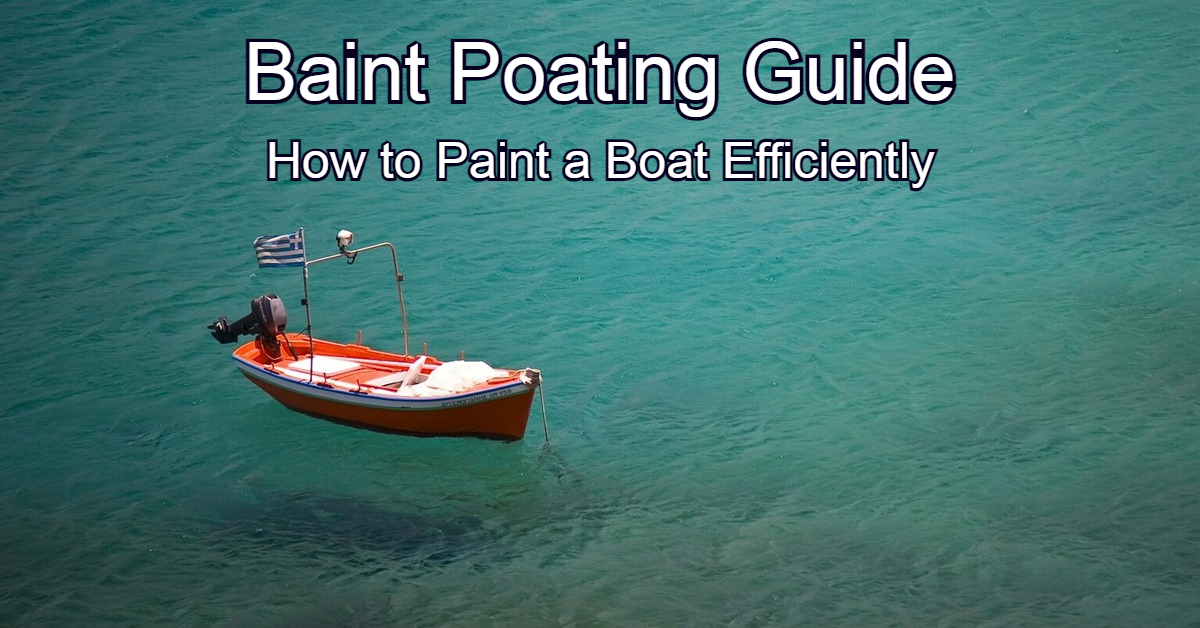
Boat Painting Guide: How to Paint a Boat Efficiently
Interested in learning how to paint a boat? Boat paint has to be tailored for water transportation and extreme weather conditions.

What Is a TEU In Regards to Marine Shipping?
What is a TEU? A twenty-foot equivalent unit (TEU) is a widely accepted standard unit of measurement in marine shipping, representing the capacity of a standard 20-foot-long container.

Sustainable and Luxurious: Discovering Split’s Yachting Paradise
Split, the Adriatic jewel, offers a yachting paradise where history meets pristine maritime beauty. Here, to rent a yacht means unlocking the gateway to exploring secluded bays, experiencing cultural heritage […]

How Much Does It Cost to Paint a Boat?
Panting your boat is an operation that must be done, especially because boats need to maintenance and and proper attention to keep always high their quality. If you’re feeling ambitious, why not try painting your boat yourself? It’s definitely not an easy job, but with the right tools and some patience, you can turn even the most drab boat into a colorful masterpiece.
Before you start painting, make sure you have all the necessary supplies. You’ll need primer , paint , brushes (both flat and round), and a drop cloth to protect your deck from paint splatters. If you’re working on a large boat , you may also need a ladder or scaffolding to reach all the surfaces.
The cost to paint a boat can vary depending on the size of the boat, the painting company, and the paint itself. The average price is around $1,500, but it could be as low as $1,000 or as high as $2,000. Some companies may charge more for boats that are over 30 feet long. Boat owners should also consider the cost of primer and other materials.
Table of Contents
Factors Affecting The Cost Of Paint A Boat
The cost of painting a boat varies depending on the size of the boat, the type of paint, and the amount of labor required. Larger boats typically require more paint and take longer to paint, which raises the cost.
Marine paints are designed to resist corrosion and fading in harsh environments, so they tend to be more expensive than standard paints . The cost of labor can also vary significantly depending on the location and the painter’s experience level. In some cases, it may be cheaper to have a professional painter do the job than to try to do it yourself.
Best Paint For Boats
In order to find the best paint for boats, it is important to consider the different types of paint and their individual benefits. For fiberglass boats , an epoxy primer and topcoat is a good option because it forms a waterproof barrier.
For aluminum boats , a corrosion-resistant paint like zinc chromate is a good choice.
Wooden boats -should be painted with an oil-based paint to seal the wood and protect it from the elements.
Cost to paint a boat hull
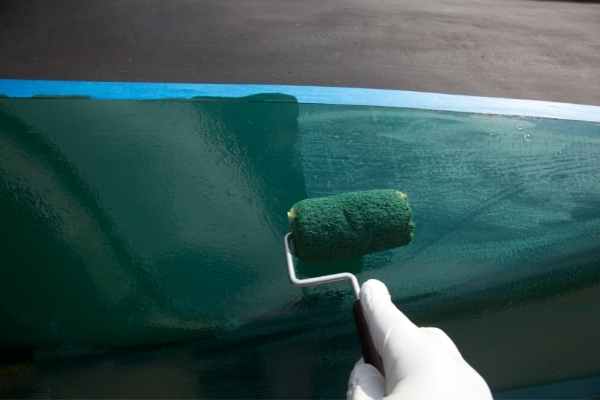
Paint can play an important role in the appearance and life of a boat. It is also necessary to keep the paint up on a boat as it’s exposed to the sun and weather. Boat hull painting can be a big task, but it’s important to do in order to protect the boat.
The cost of painting a hull can vary depending on the size of the boat, the type of paint, and the painter’s rates. Generally, though, it costs between $500 and $1,000 to have a hull painted.
One reason that painting a hull is important is that it protects the boat from UV rays. Sun damage can cause the paint to chip and flake off, which can lead to rusting and further damage to the boat. Painting also helps keep boats looking new and adds value when it comes time to sell.
Why do people Bottom paint a boat?
The main reason is to protect the boat from corrosion. The paint creates a barrier between the metal of the boat and the water. This prevents the metal from rusting and keeps the boat in good condition.
Another reason people bottom paint their boats is to make them look nicer. The paint can add color and make the boat look more polished. It can also help to protect the boat from scratches and other damage.
Finally, some people bottom paint their boats to help keep them warmer in cold weather. The paint can act as an insulator and help to keep heat inside the boat. This can be helpful in climates where it gets cold in winter months .
How Much Does it Cost to Antifoul a Boat?
The cost of antifouling a boat bottom depend on the size of the boat, the length of time it will be in the water, and the type of paint used. In general, expect to pay around $2-4 per square foot for a DIY job .
If you hire a professional, the cost will be significantly higher – expect to pay upwards of $10 per square foot . The life expectancy of an antifouling paint job ranges from 6 months to 3 years, so it’s important to factor this into your budget when planning how often your boat needs a new coat.
How often should a boat bottom be painted?
The amount of time between bottom painting depends on the type of boat, the water it’s in, and how often the boat is used. In general, boats in saltwater should be painted every six to 12 months , while boats in fresh water can go two to three years between bottom paintings . Boats that are used often or have a high moisture content need to be painted more frequently. Bottom painting protects a boat from corrosion and helps keep it looking new.
What is the best paint to use for the bottom of a boat?
When it comes to the best paint to use for the bottom of a boat, there are a few things you need to take into account. The first is the type of boat you have. There are different types of paint that work better or worse on different types of boats. Fiberglass boats, for example, require a special kind of paint that will bond well with the fiberglass surface. Wooden boats, on the other hand, require paint that can withstand moisture and extreme weather conditions.
The second thing you need to consider is the condition of your boat’s bottom. If your boat has a lot of algae or barnacles growing on it, then you’ll need a paint that can remove these build-ups. If your boat is in good condition and doesn’t have any major build-ups, then you can use any kind of paint that you want.
Topside boat painting cost
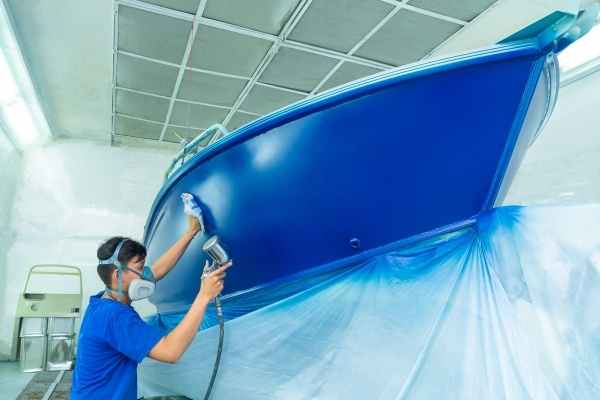
Also in this case, the cost of painting a boat’s topside depend on the size of the boat, the type of paint used and the painter’s experience. Generally speaking, a small boat (under 26 feet) will cost between $500 and $1,000 to have its topside painted, while a larger boat can run as much as $10,000 or more.
There are several factors that will affect the price of a topside paint job. The most expensive is using high-quality marine paint, which can cost up to $100 per gallon . Experienced painters typically charge more for their services than those who are just starting out in the trade. And finally, the size of the boat matters – a large craft will take longer to paint than a smaller one, so it will cost more.
Can you paint over old paint on a boat?
When repainting your boat , you may be wondering if you can just paint over the old paint. In some cases, this is possible. However, there are a few things you need to know before proceeding.
If the old paint is in good condition and adheres well to the surface, it is probably fine to paint over it. If the old paint is peeling or chipping, however, it should be removed before painting over it.
Another thing to consider is the type of paint you will be using. If you are using a latex-based paint , it is safe to paint over an existing coat of latex paint. However, if you are using an oil-based paint, you should remove the old paint first.
how much does it cost to paint a fiberglass boat

The cost to paint a fiberglass boat can vary greatly depending on the size of the boat, the number of coats of paint required, and the type of paint used. Typically, the cost to paint a small boat (14-16 feet) ranges from $200 to $600, while the cost to paint a large boat (over 26 feet) can be as much as $2,000.
The most important factor in determining the cost of painting a fiberglass boat is the type of paint used. Epoxy paints are more expensive but also more durable than conventional marine paints. If you’re looking for maximum protection against corrosion and fading, then epoxy is the way to go. However, if you’re looking for a less expensive option that will still provide good protection, then a conventional marine paint is a good choice.
How much does it cost to paint a 20 ft boat
The average cost to paint a 20-foot boat is around $500 . However, this price can vary depending on the quality of paint used, the size of the boat, and the number of coats of paint that are applied. Many people choose to do the painting themselves in order to save money, but this can be a time-consuming process. Hiring a professional to do the job can be expensive but may be worth it for those who don’t have the time or expertise to do it themselves.
Cost to paint a boat trailer
The average cost to paint a boat trailer is $350 , though this can vary depending on the size of the trailer and the paint job required. There are a few things to consider before getting your boat trailer painted.
The first is the type of paint that will be used. A standard paint job usually costs around $200-$250 , while a specialized marine paint can cost upwards of $400 . The second consideration is whether or not to have the trailer sandblasted and primed before painting. This will add an additional $50-$100 to the total cost.
Finally, it’s important to consider the condition of the trailer. If it’s in poor condition, there may be additional repairs that need to be made before painting can begin. All of these factors should be taken into account when deciding whether or not to have your boat trailer painted.

At HowMuchDoesCost, you will find costs related to everything imaginable; we collect the different costs from various sources present on the internet and give you all in one information without losing time searching for deeper pieces of information. Our main goal is to provide you with a depth overview of the cost that you need to afford for a service, animals, and much more.
Disclaimers
Privacy Policy
Terms And Conditions


Step-By-Step Guide: How To Paint A Sailboat Like A Pro
Alex Morgan

Painting a sailboat can be a rewarding and creative endeavor that not only enhances the appearance of your vessel but also offers protection against the harsh marine environment. Whether you’re a seasoned sailor or a novice boat owner, knowing how to paint a sailboat is a valuable skill. This comprehensive guide will take you through the step-by-step process of painting a sailboat, from gathering the necessary materials to applying the final touches.
To start, you’ll need a few essential materials for the painting project. These include:
1. Paint: Choose a marine-grade paint that is specially formulated for boat surfaces to ensure long-lasting durability.
2. Primer: Apply a suitable primer to create a smooth and uniform surface for the paint to adhere to.
3. Brushes and Rollers: Use high-quality brushes and rollers designed for marine applications.
4. Sandpaper: Prepare the boat’s surface by sanding it to remove any existing paint or imperfections.
5. Tape and Drop Cloths: Protect areas that you don’t want to paint by using tape and cover the surrounding surfaces with drop cloths.
Before diving into the actual painting process, it’s essential to prepare the sailboat properly. This involves a few key steps:
1. Cleaning the Surface: Remove dirt, grime, and any other contaminants from the boat’s surface using a suitable cleaning solution.
2. Repairing Any Damage: Inspect the boat for any cracks, chips, or other damage. Repair these areas using the appropriate techniques and materials.
3. Sanding the Surface: Smooth out the boat’s surface by sanding it with progressively finer grits of sandpaper. This helps the paint adhere better and provides a uniform finish.
Next, apply a primer coat to ensure proper adhesion and longevity of the paint job. Consider these steps:
1. Choosing the Right Primer: Select a primer that is compatible with the type of paint you’ll be using and suitable for the boat’s material.
2. How to Apply Primer: Follow the manufacturer’s instructions and apply the primer evenly across the entire surface of the sailboat. Use smooth, overlapping strokes for optimal coverage.
Once the primer has dried, it’s time to start painting the sailboat with the chosen paint. Keep these points in mind:
1. Selecting the Right Paint: Use a high-quality marine-grade paint that is specifically designed for boat exteriors and can withstand the effects of sun, saltwater, and other environmental factors.
2. Applying the Paint: Apply the paint using consistent and even strokes, following the manufacturer’s instructions regarding drying times and the number of coats required.
Add the finishing touches to complete the painting process:
1. Adding a Clear Coat: Consider applying a clear coat for added protection and a glossy finish. Ensure the clear coat is compatible with the paint used for the main coat.
2. Cleaning up: Clean your brushes, rollers, and any other painting equipment with the appropriate solvents, and dispose of any waste materials responsibly.
By following these steps, you can achieve a professional-looking paint job on your sailboat and enjoy the benefits of a visually appealing and protected vessel.
1. Painting a sailboat requires specific materials such as paint, primer, brushes and rollers, sandpaper, and tape and drop cloths. 2. Before painting, it is important to prepare the sailboat by cleaning the surface, repairing any damage, and sanding the surface. 3. When applying primer and paint, choosing the right products and following the correct application techniques are crucial for a successful outcome. 4. After painting, adding a clear coat and cleaning up are essential finishing touches to ensure a professional and long-lasting result.
Materials Needed for Painting a Sailboat
When it comes to painting a sailboat, having the right materials is crucial. In this section, we’ll dive into the essential items you’ll need to get started on your sailboat painting project. From paint and primer to brushes , rollers , sandpaper , and tape , we’ll explore each of these elements and how they play a role in achieving a successful paint job. So, grab your supplies, and let’s sail into the world of sailboat painting!
Painting a sailboat requires choosing the right paint for a successful and long-lasting finish. Here are some important points to consider:
1. Type of paint: Choose from marine enamel, polyurethane, or epoxy paint, as each type has its own advantages and suitability for different surfaces.
2. Durability: Opt for paint specifically formulated for marine use, with high UV resistance and excellent adhesion properties to withstand sun, saltwater, and abrasion.
3. Color selection: Select a paint color that suits your preferences and matches the overall aesthetics of your sailboat. Consider that darker colors absorb more heat and lighter colors may stain easily.
4. Finish: Decide between glossy or matte finishes. Glossy finishes are more reflective, durable, and easy to clean, while matte finishes provide a subtle and natural look.
5. Application method: Choose the application method that best suits your skill level and project size. Common methods include brushing, rolling, or spraying.
6. Coverage and drying time: Check the paint’s coverage rate and consider the number of coats needed. Also, take note of the drying time between coats, as it affects the project timeline.
7. Compatibility: Ensure the chosen paint is compatible with the primer and existing paint layers on your sailboat to prevent issues like peeling or bubbling.
8. Environmental considerations: Look for eco-friendly and non-toxic paints to minimize the impact on the marine environment.
When painting a sailboat, the primer is a crucial element to achieve a professional and long-lasting finish. Here are the key points to consider about primer:
Choose the Right Primer: It is important to select a marine-grade primer specifically designed for sailboats. This type of primer adheres well to various surfaces such as fiberglass, wood, and metal.
Apply the Primer: Make sure the surfaces are clean, dry, and free from any contaminants. To achieve a thin and even coat, you can use a brush or roller. Pay special attention to joints and areas that have been previously repaired. Allow the primer to dry completely before proceeding further.
Always remember that using the correct primer plays a crucial role in obtaining a smooth and durable paint finish on your sailboat. So take your time to choose the right primer and follow proper application techniques for optimal results .
3. Brushes and Rollers
When painting a sailboat, it’s crucial to have the appropriate brushes and rollers for a seamless and professional finish. Here are some crucial factors to consider:
1. Choose brushes and rollers of excellent quality that are suitable for the type of paint being used. Synthetic bristle brushes are effective for water-based paints , while natural bristle brushes are perfect for oil-based paints .
2. Take into account the size of the brushes and rollers. For intricate work and smaller areas, opt for smaller bristle sizes. On the other hand, for larger surfaces, larger brushes and rollers provide greater efficiency .
3. Make sure that the brushes and rollers are thoroughly cleaned and free from any residual paint or debris before starting the painting process. This will prevent any unwanted texture or imperfections on the sailboat’s surface .
4. Utilize a paint tray or bucket to hold the paint and dip the brushes or rollers into it. This will ensure even distribution and prevent any excess dripping.
5. Apply consistent pressure and strokes when using the brushes and rollers. Start painting from one end and work your way to the other, maintaining a uniform coat by maintaining consistent pressure.
By carefully selecting the appropriate brushes and rollers and using them correctly, you can achieve a paint job on your sailboat that looks professional .
4. Sandpaper
When painting a sailboat, sandpaper is crucial in preparing the surface for a smooth finish. Here are important points to consider about sandpaper:
1. Grit selection: Choose the right grit based on the surface condition. For rough sanding or removing old paint, use a coarse grit (80 or 100). For finer sanding and smoothing, use a medium or fine grit (120 or 220).
2. Sanding technique: Hold the sandpaper firmly and sand in a circular or back-and-forth motion. Apply even pressure to prevent unevenness. Sand evenly across the entire surface to remove imperfections or roughness.
3. Progression: Start with coarse grit and gradually switch to finer grits. This smoothes the surface and achieves a professional finish. Clean the surface between grit changes to remove dust or debris.
4. Safety precautions: Wear goggles and a mask to protect against sanding dust. Work in a well-ventilated area or use a dust collection system to minimize airborne particles.
5. Surface evaluation: After sanding, inspect for smoothness and uniformity. If rough spots or imperfections are visible, resand those areas before priming and painting.
The first documented use of sandpaper dates back to 13th-century China. Crushed shells, seeds, and sand were glued to parchment to create abrasive sheets. Over time, sandpaper production techniques evolved, and it became widely used in various industries for surface preparation, woodworking, and finishing applications. Today, sandpaper continues to be an essential tool for achieving smooth surfaces in painting and other projects.
5. Tape and Drop Cloths
When painting a sailboat, the use of tape and drop cloths is essential to protect areas from paint. Here are some important points to consider:
Choose painter’s tape to create clean lines, avoiding regular masking tape.
Prepare the surface by cleaning and drying it to ensure proper adhesion.
Carefully apply the tape along the edges, pressing firmly for good adhesion.
Use drop cloths or plastic sheets to protect surfaces from paint spills or splatters.
Overlap the tape slightly for smooth, clean edges and prevent paint seepage.
Remove the tape at a 45-degree angle when the paint is dry to the touch but not fully cured.
Following these steps will help you effectively use tape and drop cloths while painting a sailboat, ensuring a professional look and protecting desired areas.
Preparing the Sailboat for Painting
Get ready to transform your sailboat into a work of art! In this section, we’ll dive into the crucial steps of preparing your sailboat for painting. From cleaning the surface and repairing any damage to sanding it down, we’ll cover everything you need to know to ensure a smooth and long-lasting paint job. So grab your brushes and let’s get started on this exciting journey of turning your sailboat into a masterpiece .
1. Cleaning the Surface
When cleaning the surface of a sailboat before painting, it is important to follow these steps for thorough cleaning .
Start by removing any loose or flaking paint using a scraper or wire brush.
Next, wash the surface with a mild detergent or boat cleaning solution to effectively remove dirt, grease, or grime .
Rinse the surface thoroughly with clean water to ensure all cleaning solution residue is removed.
Take the time to inspect the surface for any stubborn stains or marks .
If needed, utilize a specialized boat hull cleaner to effectively eliminate them.
To create a smooth and even surface for paint adhesion, gently sand the surface with fine-grit sandpaper .
After sanding, wipe down the surface with a clean cloth or sponge to eliminate any dust or debris .
If you come across areas with mold or mildew , treat them with a mildew remover and allow it to sit for the recommended time before rinsing.
Ensure that the surface is completely dry before proceeding with painting or other preparation steps .
By diligently following these steps, you can guarantee that the sailboat’s surface is thoroughly cleaned and ready for painting , ultimately resulting in a professional and smooth finish .
2. Repairing Any Damage
To effectively repair any damage on a sailboat, follow these steps:
1. Assess the damage: Carefully inspect the sailboat for any cracks, scratches, or holes in the hull or deck.
2. Gather necessary materials: Make sure you have epoxy resin, fiberglass cloth, sandpaper, and a putty knife on hand.
3. Clean the damaged area: Use a mild detergent and water to remove any dirt, grime, or loose particles.
4. Sand the damaged area: Lightly sand the area to create a smooth surface for the upcoming repairs.
5. Apply epoxy and fiberglass: Follow the manufacturer’s instructions to prepare and apply the epoxy resin to the damaged area. Place layers of fiberglass cloth, ensuring complete coverage.
6. Sand and smooth the repair: Once the epoxy cures, carefully sand the repaired area for a smooth finish that seamlessly blends with the surrounding surface.
7. Prime and paint: If necessary, apply primer before painting to ensure proper adhesion. Then, paint the area to match the rest of the sailboat.
8. Clean up: Dispose of waste materials properly and clean your tools and work area.
By following these steps, you can expertly repair any damage on a sailboat while maintaining its structural integrity and overall appearance.
3. Sanding the Surface
To achieve a smooth and uniform surface, it is important to properly sand the boat’s surface. Gather all the necessary materials, including sandpaper of different grits ( 60 , 120 , and 220 ), a sanding block or power sander, and safety goggles . Before starting, make sure to protect areas that you don’t want to sand by using masking tape or drop cloths .
Begin the sanding process by using 60 grit sandpaper. This will effectively remove rough spots, peeling paint, or any previous coatings. When sanding, use a circular or back-and-forth motion with even pressure. It is crucial to avoid aggressive sanding that could potentially damage the boat’s structure.
Continuously check the surface for smoothness and evenness. Once the desired level has been achieved, switch to 120 grit sandpaper. This will further refine the surface and eliminate any remaining imperfections. Repeat this process with 220 grit sandpaper to ensure a completely smooth and uniform surface.
After sanding, ensure that the surface is thoroughly cleaned. Use a vacuum or tack cloth to remove any dust and debris. Take the time to inspect the sanded surface for any areas that may require additional sanding or touch-ups before moving forward with the painting process.
Throughout the entire sanding process, it is crucial to prioritize safety. Always remember to wear safety goggles and a mask to protect yourself from any airborne particles and dust that may be generated while sanding.
Applying Primer on the Sailboat
Applying primer on a sailboat is a crucial step in the painting process, ensuring a smooth and durable finish. In this section, we’ll dive into the essentials, from choosing the right primer to the step-by-step application techniques . So grab your brushes and get ready to give your sailboat the perfect foundation for a flawless paint job!
1. Choosing the Right Primer
Choosing the Right Primer
When painting a sailboat, selecting the appropriate primer is crucial for achieving a smooth and durable finish. Here are the steps to follow in choosing the right primer:
Assess the surface: Inspect the sailboat’s surface for damages such as cracks, dents, or peeling paint before choosing a primer.
Determine the surface type: Different sailboats may have fiberglass, wood, or metal surfaces. Select a primer designed for the specific surface.
Consider the environmental conditions: Take into account the climate and weather conditions the sailboat will be exposed to. Choose a primer with excellent corrosion resistance if the boat will be in harsh conditions or saltwater.
Choose the right primer type: There are epoxy primers, self-etching primers, and high-build primers available. Consider the needs of your sailboat and choose a primer with good adhesion and durability.
Consult professionals: Seek advice from paint specialists or experienced boat painters if unsure about which primer to choose.
By following these steps, you can ensure you choose the right primer for your sailboat, leading to a successful painting project.
Sailboat painting has a long-standing tradition in maritime culture. In the past, sailors used a mixture called “ship paint” consisting of tar and natural materials. This protected the boats from rot and deterioration and improved their performance in the water. Nowadays, sailors have a wide range of primers and paints designed specifically for sailboats. The right primer choice is critical for preserving and enhancing the beauty and functionality of sailboats. So, when embarking on a sailboat painting project, take the time to carefully choose the right primer for a successful outcome.
2. How to Apply Primer
To properly apply primer on a sailboat, follow these steps on how to apply primer:
1. Clean the surface: Before applying primer, it is important to ensure that the sailboat surface is thoroughly cleaned and free from any dirt, dust, or debris. To clean it effectively, use a mild cleaner or soap and water.
2. Repair any damage: Take a close look at the sailboat to identify areas that require repair. If you find any cracks, dents, or holes, use a suitable filler or epoxy to fix them.
3. Sand the surface: To create a smooth and even surface for painting, lightly sand the entire area that needs to be primed. Make sure to use fine-grit sandpaper and remove any loose or peeling paint.
4. Choose the right primer: Selecting the appropriate primer is crucial. Look for a primer that is specifically designed for boats and marine surfaces. Consider factors such as the type of paint, boat material, and any requirements specified by the manufacturer.
5. Apply the primer: Before applying the primer, stir it thoroughly to ensure proper consistency. Apply a thin and even coat of primer using a brush or roller. Work in small sections, and make long, smooth strokes along the natural lines of the boat.
By following these steps, you can effectively apply primer to your sailboat, creating a smooth and durable base for the paint.
Painting the Sailboat
Painting the Sailboat is where the real magic happens! Get ready to transform your plain sailboat into a work of art. In this thrilling section, we’ll dive into the nitty-gritty details of painting your beloved vessel. Discover the secrets to selecting the perfect paint that not only adds a pop of color but also protects your boat from the harsh elements. Then, we’ll uncover the techniques for applying the paint like a pro, ensuring a flawless finish that will make heads turn. Get ready to unleash your creativity and make your sailboat truly shine!
1. Selecting the Right Paint
Selecting the Right Paint
– Type of paint: When selecting the right paint, it’s important to consider the options available such as marine enamel paint , epoxy paint , and polyurethane paint . Each type has its own set of advantages and disadvantages, so it’s important to choose the one that best suits your needs and budget.
– Compatibility: Making sure that the paint you choose adheres well to the sailboat’s surface is crucial. This will help ensure a long-lasting and durable finish.
– Color: The color you choose for your paint should not only be based on your personal preference, but also on how well it complements the overall aesthetic of the sailboat. It’s also important to consider how the color will be affected by sunlight and weathering over time.
– Durability and resistance: In a marine environment, it’s essential to select a paint that is formulated to withstand the harsh conditions. Look for paint options that offer UV resistance , saltwater resistance , and resistance to scratches and abrasions.
– Application method: Depending on the paint you choose, different application methods may be required. Some paints may need to be sprayed, while others can be applied with a brush or roller. It’s important to choose a paint that aligns with your level of expertise and the equipment you have available.
– Budget: Consider your budget when selecting the right paint. Different paints come at different price points, so it’s important to choose one that offers a balance between quality and affordability.
2. Applying the Paint
To apply paint on a sailboat, follow these steps:
– Preparation: Clean and dry the surface before applying paint. Remove dirt, dust, or grease using a cleaning solution and cloth.
– Tape and protect: Mask off areas that you don’t want to paint, such as windows or hardware, using tape. Cover surrounding areas with drop cloths to prevent accidental splatters.
– Primer: Apply a coat of marine-grade primer to the sailboat following the manufacturer’s instructions. Allow the primer to dry completely.
– Select the paint: Choose a marine-grade paint suitable for the sailboat’s material. Consider durability, weather resistance, and color. Follow the recommended applicator type.
– Application: Apply paint to larger areas of the sailboat first using a roller or brush. Use smooth, even strokes for a uniform finish. Work in sections, moving from one part to another.
– Second coat: Assess if a second coat is needed once the first coat has dried. Apply a second coat following the same technique for a vibrant and long-lasting finish.
– Clean up: Clean brushes and rollers according to the paint manufacturer’s instructions. Dispose of used materials properly.
By following these steps, you can effectively apply paint to your sailboat and achieve a beautiful and protective finish.
Finishing Touches
The Finishing Touches section is where we add the final elements to our sailboat painting, giving it that extra dose of awe-inspiring sophistication . In this part, we’ll dive into two key sub-sections: Adding a Clear Coat and Cleaning up . Prepare for the exhilarating moment of applying the clear coat, which not only enhances the colors but also protects the artwork for years to come. Plus, we’ll share some neat tips on how to clean up any stray brushstrokes or smudges effortlessly. Let’s make this sailboat masterpiece shine !
1. Adding a Clear Coat
To incorporate the provided keywords naturally in the provided text, the rewritten text can be as follows:
To add a clear coat to a painted sailboat and ensure long-lasting protection for your sailboat, follow these steps:
Ensure the painted surface is clean and completely dry .
Use a high-quality clear coat designed for marine applications , specifically for adding a clear coat.
Apply the clear coat in thin , even layers using a brush or spray gun .
Allow each layer to dry completely before applying the next layer, contributing to the process of adding a clear coat.
Cover the entire surface of the sailboat with the clear coat for maximum protection , fulfilling the purpose of adding a clear coat.
Check for any drips or uneven spots and sand them down before adding more coats, which is an essential part of adding a clear coat.
Follow the manufacturer’s instructions to determine the number of coats needed, a vital step in successfully adding a clear coat.
Adding a clear coat to a painted sailboat is crucial for protecting the paint job from UV radiation , saltwater , and other damaging elements. By following these steps and using the appropriate materials for adding a clear coat, you can achieve a professional-looking finish and ensure long-lasting protection for your sailboat.
2. Cleaning up
Cleaning up after painting a sailboat is an important step that ensures a neat finish and maintains the longevity of your painting tools. To effectively clean your sailboat, follow these steps:
- Remove excess paint from brushes and rollers.
- Clean brushes and rollers with warm soapy water.
- Rinse brushes and rollers to remove soap residue.
- Allow brushes and rollers to air dry completely.
- Dispose of leftover paint or materials according to local regulations.
- Remove protective tapes and drop cloths from the sailboat.
- Collect debris or trash and dispose of properly.
- Wipe down the sailboat with a clean cloth to remove dust or particles.
- Inspect the area for touch-ups or missed spots and make necessary corrections.
- Store brushes, rollers, and other painting materials in a clean and dry place for future use.
These steps will help you incorporate the cleaning up process into your sailboat painting routine effectively. Sailors have always taken pride in keeping their vessels clean for efficiency and well-being. Proper cleaning techniques have been passed down through generations to preserve sailboats. Today, sailors continue to adhere to these principles to honor the traditions of the sea.
Some Facts About How To Paint A Sailboat:
- ✅ Painting your sailboat is essential for its safety and protection. (Source: Life of Sailing)
- ✅ The paint acts as a barrier against salt, barnacles, and rotting, keeping your sailboat well-maintained. (Source: Life of Sailing)
- ✅ Painting your sailboat yourself can save you money and allow you to acquire a valuable skill. (Source: Life of Sailing)
- ✅ The frequency of painting depends on the type of paint and the amount of time your boat spends in the water. (Source: Life of Sailing)
- ✅ Choosing a sailboat paint that contains copper provides biocidal properties, preventing the attachment of sea life. (Source: Life of Sailing)
Frequently Asked Questions
How important is painting a sailboat for its safety and protection.
Painting your sailboat is essential for its safety and protection. The paint acts as a protective layer, guarding against saltwater corrosion, barnacles, and rotting. It also adds an added layer of aesthetic appeal to your boat, making it stand out.
What are the benefits of painting a sailboat yourself?
Painting your sailboat yourself offers several benefits. It allows you to save money as you won’t have to hire a painting contractor. It provides an opportunity to learn a valuable life skill. It allows you to add your creative flair and personalize the paint job according to your preferences.

Which paint brands are recommended for painting a sailboat?
When painting a sailboat, it is recommended to choose paint brands that contain copper. Copper acts as a biocide, preventing the attachment of sea life to the boat’s hull. This helps in maintaining the boat’s performance and reduces the need for frequent cleaning and maintenance.
What is the frequency of painting a sailboat?
The frequency of painting a sailboat depends on the type of paint used and the amount of time the boat spends in the water. Bottom paint, which protects the hull, should be applied annually. On the other hand, top paint, which adds color and gloss to the boat, can be done every 3 years.
What are the necessary tools for painting a sailboat?
When painting a sailboat, you will need various tools such as sandpaper, paint, primer, brushes, rollers, paint thinner, and solvent. It is essential to have a well-ventilated workspace and ensure you wear safety gear such as a face mask, goggles, and gloves.
What is the process for painting a sailboat?
The process for painting a sailboat involves several steps. First, inspect the boat for any damage and make necessary repairs. Next, sand the surface using different grits of sandpaper to achieve a smooth finish. Then, apply a layer of primer to improve adhesion. Apply multiple coats of paint, allowing sufficient drying time and sanding between each coat for a glossy looking boat. Good luck!
About the author
Leave a Reply Cancel reply
Your email address will not be published. Required fields are marked *
Save my name, email, and website in this browser for the next time I comment.
Latest posts

The history of sailing – from ancient times to modern adventures
History of Sailing Sailing is a time-honored tradition that has evolved over millennia, from its humble beginnings as a means of transportation to a beloved modern-day recreational activity. The history of sailing is a fascinating journey that spans cultures and centuries, rich in innovation and adventure. In this article, we’ll explore the remarkable evolution of…

Sailing Solo: Adventures and Challenges of Single-Handed Sailing
Solo Sailing Sailing has always been a pursuit of freedom, adventure, and self-discovery. While sailing with a crew is a fantastic experience, there’s a unique allure to sailing solo – just you, the wind, and the open sea. Single-handed sailing, as it’s often called, is a journey of self-reliance, resilience, and the ultimate test of…

Sustainable Sailing: Eco-Friendly Practices on the boat
Eco Friendly Sailing Sailing is an exhilarating and timeless way to explore the beauty of the open water, but it’s important to remember that our oceans and environment need our protection. Sustainable sailing, which involves eco-friendly practices and mindful decision-making, allows sailors to enjoy their adventures while minimizing their impact on the environment. In this…
RetireFearless
Cost To Paint The Hull Of A Sailboat
Are you looking to repaint your sailboat’s hull? Many factors impact the cost of hull painting. So, how much does it cost to paint the hull of a sailboat?

March 16, 2023
This article may contain affiliate links where we earn a commission from qualifying purchases.
Whether you’re a first-time boat owner or you’ve been sailing for years, one of the most important decisions you’ll make is how to paint your hull. It’s not a decision to take lightly - the wrong color or coatings can be costly and time-consuming mistakes. So, what’s the right way to go about it?
If you are painting the sailboat hull yourself, the equipment cost will be your primary expense, which will typically amount to around $600. If you factor in your time at $20, the cost can go up to $800. In comparison, having the hull painted by a professional can cost about $1,000.
Paint is an important part of a sailboat. It protects the hull from weather and adds to the aesthetics of the vessel. However, you should not consider a figure only by the size of your boat. Various factors affect the cost heavily. These include the type of paint, boat location, number of coats required, design complexity, etc.
As sailing experts, our community members have had their sailboat hulls painted several times over the last decade. So, we’ve put together this guide to help you understand the cost of painting a sailboat hull.

Table of Contents
How Much Does it Cost to Paint the Hull of a Boat?
Diy hull painting.
Painting a sailboat hull yourself can be a gratifying experience. Not only will you save money on the project, but you’ll also get to add your personal touch to your boat. However, it’s important to understand the costs before you start painting.
The cost of paint and other materials will vary depending on the size of your boat and the type of paint you choose. For example, if you have a large boat, you’ll need to purchase more paint than someone with a smaller vessel. Additionally, high-quality paints will cost more than lower-quality options. However, keep in mind that using higher quality materials will result in a better-finished product.
Let’s say you have a 30-foot sailboat with a hull that needs painting. How much will it cost you to do the job yourself? First, you’ll need to purchase the paint (about $200 for a good quality marine paint ), plus primer (if needed), brushes, and other supplies. You’ll also need to allow for the cost of renting a scaffold or ladder if you don’t have one.
In addition to the cost of paint and other materials, you’ll also need to factor in the cost of your time. Painting a sailboat hull is a big job, and it will take several days to complete. If you’re not experienced in painting, it’s essential to factor in the time it will take you to learn the necessary skills.
Assuming you’re doing the job right and taking your time, it takes about 20 hours to complete the job. If you value your time at $20 per hour, that’s an additional $400. So all told, you’re looking at the cost of around $600 to $800 to paint your sailboat hull yourself. Of course, this is just a rough figure - your actual costs may be lower or higher depending on the size and condition of your boat, the type of paint you use, and other factors.
Hiring an Expert for Hull Painting
It can cost anywhere from $500 to $3,000 to paint a sailboat hull, depending on the size of the boat and the type of paint used. If you hire a professional painter, they will typically charge by the hour or square foot. The average cost per hour is around $50.
We will take the same boat size as an example for DIY painting. A 30-foot boat would require about 20 hours of work, which would come out to a total cost of $1,000.
The type of paint you use will also affect the overall cost. There are two main types of paint: one-part and two-part polyurethane. One-part polyurethane is less expensive but doesn’t last as long, while two-part polyurethane is more expensive but will last longer.
It’s best to consult with a professional painter to get accurate pricing for painting your sailboat’s hull. They will be able to give you a tailored estimate based on the size of your boat and the type of paint you want to use.
Types of Paint
The type of paint can affect your hull painting cost heavily. Below, we take a look at the different types of paints.
Aluminum Boat Paint
Aluminum boat paint is a type of paint specifically designed for use on aluminum boats. Unlike most other types of paint, it can withstand harsh conditions in open water, including saltwater and UV exposure.
Aluminum boat paint is available in various colors and finishes to choose the perfect look for your boat. It is important to note that aluminum boat paint is not compatible with all types of primer and topcoats, so be sure to consult with a professional before beginning your project. With proper care and maintenance, your aluminum boat will look great for years to come.
Topside Boat Paint
Topside boat paint is a type of marine paint used on the exposed upper surfaces of a boat, such as the hull, sides, and deck. Unlike bottom paint, topside paint is not designed to be submerged in water. Instead, it must be able to withstand the harsh conditions of the elements, including UV rays, salt water, and wind.
Topside paint is typically made from high-quality oil- or latex-based paint with added UV protection. It can be applied with a brush, roller, or spray gun and is usually available in a variety of colors. When choosing a topside paint, it is important to select one that is specifically designed for use on boats. Using standard exterior paint will not provide the same level of protection or durability.
Fiberglass Coatings
Fiberglass paint is a type of paint specifically designed for use on fiberglass surfaces. It usually comes in a spray can and dries to a hard, glossy finish. Fiberglass paint is more durable than regular paint, and it resists fading and chipping. When choosing a fiberglass paint, select one compatible with the type of fiberglass you are painting. For example, if you are painting a boat hull, you will need marine-grade fiberglass paint.
The key to success with fiberglass paint is appropriately preparing the surface before painting. This means sanding down any rough edges and cleaning the surface thoroughly. Once the surface is prepped, you can apply the paint just like any other type of paint. Just be sure to use a brush specifically designed for fiberglass surfaces to avoid damaging the finish.
Wood Boat Paint
Wood boat paint is a type of paint specifically designed for use on wooden boats. It is usually made from a mix of oil and resin, which helps to protect the wood from water damage and rot. Wood boat paint can be applied to both the exterior and interior of a boat, and it is important to choose a paint specifically designed for maritime use.
There are several different types of wood boat paint available on the market, and it is vital to select the right one for your particular boat. Some factors to consider include the type of wood your boat is made from, the climate you live in, and the amount of sunlight exposure your boat will receive. It is best to consult with a professional before selecting a wood boat paint.
Bottom Boat Paints
Bottom boat paints are coatings applied to the bottom of a boat to protect it from the elements. The most common type of bottom paint is anti-fouling paint, which helps prevent the growth of barnacles and other aquatic creatures on the hull. Bottom paints can also protect from UV rays, saltwater, and oxidation.
Different formulas are available for different boats, so choosing the right one for your vessel is crucial. In general, bottom boat paints should be applied every two years or as needed. Most manufacturers will provide specific instructions on applying the paint and how often it needs to be reapplied.
What Factors Influence the Cost of Painting the Hull of a Sailboat?
The following factors influence the cost of painting a sailboat’s hull:
- The size of the sailboat hull
- The type of paint used
- The location of the boat
- The complexity of the design
- The number of coats required
- Prep work that needs to be done before painting can begin
- Whether or not a professional painter is doing the job
- How long the job will take to complete
The size of the hull is perhaps the most critical factor, as a larger surface area will require more paint and take more time to complete. The type of paint used is also significant, as different grades and quality of paints are available on the market. The boat’s location can also play a role, as some locations may be more expensive to have work done - if the boat is in a dry dock or on land, it will be easier to access and work on than if it is in the water.
The complexity of the design is also something to consider, as a more intricate design will likely take more time to complete. Finally, the number of coats required is also a key factor, as more coats will obviously require more paint and take longer to apply. All of these factors must be considered when estimating the cost of painting a sailboat hull.
Prep work that needs to be done before painting can begin, whether or not a professional painter is doing the job, and how long the job will take to complete are essential factors that influence the cost of painting a sailboat hull. This can include stripping old paint from the hull, which is time-consuming and expensive.
If you are considering having your sailboat hull painted, be sure to take all of these factors into account to get an accurate estimate of the total cost.
Maintaining the Finish on Your Boat’s Hull
Your boat’s hull is its most important feature - it’s what keeps you afloat! So it’s important to keep the finish in good condition and cut down costs of repair and repainting. Here are a few tips for maintaining the finish on your boat’s hull:
- Wash the hull regularly with fresh water and mild soap. This will help remove any dirt or grime that could cause the finish to become dull.
- Apply a good quality wax regularly. This will help protect the finish from sun damage and other environmental factors.
- Be careful when docking or mooring your boat. Bumps and scrapes can damage the finish, so it’s important to use soft lines or fenders to protect the hull.
By following these simple tips, you can help to keep your boat’s hull looking like new for years to come!
Recent Articles

What Size Sailboat Can One Person Handle?

How To Tie A Sailboat To A Mooring Ball Ring

What Is The Ideal Wind Speed When Sailing?

How To Use a Sailboat Winch

Things You Need To Liveaboard a Sailboat

Types of Sailboat Keels
I'm Michael Moris. I've been sailing my whole life, and it has taken me to places I never imagined. From the Caribbean to Europe, from New Zealand to South America - there's nowhere that hasn't felt like home when you're on a boat!

Trending Articles

How Far Is Havana From Miami By Boat?

Yachting Vs Sailing

Who Is Sailing Doodles?
Subscribe To Our Newsletter
Thank you! You're signed up for our free newsletter!
Oops! Something went wrong while submitting the form
About Our Team
We are a publishing team of licensed Nursing Home Administrators, Nurses, Assisted Living Directors, Health Professionals, Gardeners, and individuals with vast experience with senior living and activities.

©2024 Retire Fearless. All rights reserved.
We can be reached via email at [email protected]
Retirefearless.com is a participant in the Amazon Services LLC Associates Program, an affiliate advertising program designed to provide a means for sites to earn advertising fees by advertising and linking to Amazon. This site also participates in other affiliate programs such as CJ, ClickBank and more, and is compensated for referring traffic and business to these companies.
Facebook Pinterest

Please verify you are a human
Access to this page has been denied because we believe you are using automation tools to browse the website.
This may happen as a result of the following:
- Javascript is disabled or blocked by an extension (ad blockers for example)
- Your browser does not support cookies
Please make sure that Javascript and cookies are enabled on your browser and that you are not blocking them from loading.
Reference ID: 4abcd99c-14cd-11ef-8ee0-0aed58611b48
Powered by PerimeterX , Inc.

A Trusted Source For Boating Information Since 2019
Should you paint or re-gelcoat a boat hull.
- Post Written By: Boater Jer
- Published: May 2, 2021
- Updated: July 8, 2022

Disclaimer: You might notice that we recommend products in some articles. We may earn a commission for referring you if you click the link and buy a product.
We only recommend products we’ve tried/tested/own (that’s why you won’t find thousands of affiliate links on my site). If you have experience with one of the products we’ve mentioned, please share your experiences in the comments at the end.
Advertisement

A regularly waxed gelcoat can last for up to 15 years on the boat. This figure can vary based on how well you take care of your boat’s hull. If you’re having trouble deciding whether to re-gelcoat or paint the hull, here’s a fantastic guide for you (and your boat).
It is safe to paint the hull if the gelcoat is in good condition. A good condition gelcoat is one, which still retains gloss and does not show white chalky powder on the surface. If the gelcoat lacks these signs, then re-gelcoat the boat’s bottom, or else I recommend painting at least.
This article talks about whether you should paint or re-gelcoat your hull. We will also cover the steps to re-gelcoat and paint the hull. So keep reading this article until the end for more information!
Re-gelcoat The Hull
Let’s see when you should re-gelcoat the hull along with the quick steps for the same, before getting started, inspect the gelcoat.
If it’s still in good condition, it shows no sign of wear, tear, damage, cracks, etc., there is no need to re-gelcoat. In such a case, follow the steps below to get the job done at the earliest.

- Clean the gelcoat surface.
- Apply an epoxy primer on the surface.
- Sand the primer until you think it’s sufficient.
- Clean the sanding residue and finally apply the topcoat. You can also paint the surface if you feel so.
If there is a crack(s) (no matter the size) or the gel coat’s surface is somewhat chalky, then you MUST do the repairs. For this, follow these quick steps:
- Clean the gelcoat to prepare the surface. Make sure that there are no residues of oil, wax, dirt, etc.
- Now scrub the surface with the soap water, and don’t forget to rinse the soap residue. If the water does not separate while flowing down the surface, that means you’ve cleaned the surface correctly.
- Carefully inspect the surface for any damages such as cracks, dents, etc. Fix the issues on the surface (if any) before proceeding any further.
- Now it’s time for sanding. You may use 320 to 400-grit sandpaper. Unfortunately, the sanding will leave some residue again, so wipe them off to get a clean, beautiful surface.
- Apply the gelcoat. 2-3 layers might be sufficient.
Painting The Hull

If you don’t want to gelcoat the bottom of the boat, you may paint it alternatively. Leaving the hull’s surface unprotected will let organisms spread all over the surface, which will hinder the boat’s speed, handling, and overall performance. Furthermore, it can cause minor to severe damages to the surface over time, which is troublesome in the long run.
The painting will, without a doubt, increase the lifespan of the boat drastically. If your boat stays in the water for a long time, painting the hull is strongly recommended.
Gelcoat Vs. Paint- A Strong Debate
In some cases, gelcoat proves to be better than paint and vice versa. We will now take a look at a few points in the form of an interesting debate.
Gelcoat can effectively protect your boat’s bottom against UV and harmful chemical reactions that might take place on its surface. Since the bottom part of the boat is exposed to several kinds of chemical reactions taking place in the water, the gelcoat layer will give you a huge advantage. On the other hand, paint is practical and offers protection against such issues, but to a minimal extent, comparatively.
Repairing Cost And Other Requirements
Gelcoat application can be expensive as compared to paint. But the longevity of the gelcoat still makes it cheaper than paint and worth every penny. Please remember that gelcoat will be expensive only if you’re re-coating the surface from scratch. Minor repair/patchworks, on the other hand, will be cheap. Furthermore, gelcoat application can be tiring, requiring a lot of patience, skills, and of course, all the materials to prep and apply.
Paint, on the other hand, does not demand as much time, skills, or money. So if you can’t invest much time, we recommend you to go for the paint. Furthermore, if you’re impatient and lack the required skills to gelcoat the surface, then painting the bottom of the boat is the best way to stay on the safe side rather than messing up everything.

The major disadvantage of the paint here is that you will have to repaint the surface every year. Although paint can last for about 8 to 10 years, for the sake of the boat’s longevity, paint it once every year or two. The painted surface can fade sooner than expected, even though it can still offer protection at the same time. Gelcoat, on the other hand, will retain its shine for years.
Self-Leveling
Unfortunately, gelcoat IS NOT self-leveling. If you’re working with the gelcoat for the first time, or if you’re still a newbie, there is a reasonably high chance that you will fail to level the gelcoat properly. To overcome this issue, you can use sandpaper to level up the gelcoat. Paint, on the other hand, does not need to be leveled up. No hassle, quick and straightforward!
Comparison Table For Gelcoat And Paint
You might want to take a look at the comparison between gelcoat and paint to get a better idea of whether to re-gelcoat or paint the boat’s bottom.
The Last Few Knots
We will now try to settle the debate on gelcoat or paint. Remember that it’s the hull we’re talking about here. Since the hull will be in contact with water the entire time, extra safety measures are essential. Therefore, gelcoat is a better option. But when do you need to do it?
When To Re-Gelcoat The Hull?
Here are a few conditions and situations in which you should opt for the reapplication of gelcoat instead of painting your boat’s bottom.
- If you can afford to re-gelcoat the entire hull from scratch, then go for it. Remember that in addition to the gel coat’s cost, you will also have to spend on repair work (if any) on the hull’s surface.
- Re-gelcoat in the case where you have enough skills, time, and patience. Since this work requires heavy labor, go for it only if you can do so. Hiring someone to get the work done will further increase the total cost of repair work.
- To re-gelcoat, you will need a well ventilated open space and do the repairs on a clear day. If you lack these things, then maybe you should drop the idea to re-gelcoat the boat.
- If you leave the boat in the water for a long time (or maybe regularly), then we strongly recommend that you re-gelcoat the hull. Paint won’t be as useful in this case.
- Re-gelcoat your boat’s bottom if the old gelcoat is all worn out, and there’s no way to revive it.
When to Paint The Hull?
The following situations favor painting your boat’s bottom instead of reapplication of gelcoat.
- If you’re low on budget and can’t afford to spend on the gelcoat and then on repairs, then paint the boat. But remember that you’ll need to repeat the process in a year or two.
- Opt for paint if you don’t want to spend the whole day repairing the boat. Paint the bottom of the boat and let it dry.
- Painting does not need as well-ventilated or open space as a gel coating might require. Just try to avoid doing it on a rainy day, as the air will be full of moisture from high humidity.
- If you will take your boat in water occasionally or rarely, then painting is recommended.
- You can paint the boat’s bottom over the old gelcoat if the gelcoat is in good condition. It will give an added layer of protection to your hull and revive shine for a while.
- If you’re not getting your desired color options in the gelcoat, then you can paint your favorite color on the bottom of the boat.
We have covered all the points necessary to help you decide whether to re-gelcoat or paint the boat. It’s totally up to you what to choose, and now that you’ve learned enough, it’s time for you to act. Good Luck!

- https://www.sailmagazine.com/diy/how-to-prepare-your-boat-for-painting-a-gelcoat
- https://www.boatdesign.net/threads/wanting-to-apply-new-gel-coat-over-old-gel-coat.51852/
- https://findanyanswer.com/how-much-does-it-cost-to-get-a-boat-gel-coat
- https://www.myyachtmanagement.com/news/2018/gelcoat-finish-vs-marine-paint-for-your-yachts-hull#:~:text=Painted%20hulls%20are%20especially%20resistant,less%20durable%20than%20gelcoat%20finish.&text=It%20dries%20to%20a%20glossy,additional%20clear%20glossy%20top%20coat .
- https://www.thehulltruth.com/boating-forum/251438-gel-coat-vs-paint.html

Crab Island by Pontoon: A Fun Watery Boating Guide Destination in 2024

Upgrade Your Boating Experience: Adding a Third Pontoon Made Easy!

How Long Does It Take A Canoe To Go… (Canoe Calculator Here)

In-Depth Review of the Pelican Sentinel 100X Fishing Kayak: Pros, Cons, and Performance

How To Put A Kayak In The Water – The Ultimate Guide For New Kayakers

Best Cruising Catamarans For Couples
- PowerDolphin Wizard Water Surface Drone – Best Surface Drone?
- Aluminum vs. Fiberglass Bass Boats
- Sailor’s Superstition: Why Are Green Boats Unlucky?
- How To Make A V-hull Boat More Stable – Increasing Watercraft Stability
fakerolex.to

Share this post with your friends
Subscribe to our newsletter.
Join us in our love for all things water. And Adventure.

How Much Does A Catamaran Cost? (Big Crazy $$$?)
Advertisement You’ll want to know the Catamaran cost if you find sailing on lakes and fishing exciting. Then, a catamaran boat is your best bet. A catamaran is a watercraft featuring two parallel hulls. The name ‘catamaran’ is from the Tamil word, kattumaram, which means logs bound together looking like the first fishing boat designs.

Can a Sailboat Tip Over? Here’s What You Need To Know!
Advertisement Can a sailboat tip over? A common question asked by new sailboat owners and sailing enthusiasts.Sailing is a sport and can also provide a great form of recreation for people of all ages. It involves the use of wind and sails to propel a boat forward.To find out the answer to this question and

The Eyoyo Portable Underwater Fish Finder and Camera Review
Advertisement A fishing trip is something that can excite any man (and some women too). You get to enjoy good times outside with your friends. Nevertheless, the pain of being unable to catch any fish may be yet to come. If you’re one such unlucky person, who is having a hard time catching even a
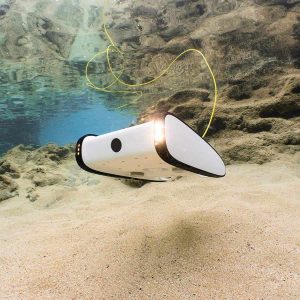
The Trident Underwater Drone Bundle – Best Deal Under The Sea?
Advertisement ROVs, or underwater drones, are enhancing the fun element of video and image shooting from totally astonishing angles. If you are a videography/ photography enthusiast, then you know what we are talking about here. You are always on the lookout for different perspectives to shoot footage, and what could amaze you more than a

Can Canoes Sink?
Advertisement Going canoeing is both a fun and rewarding endeavor. Sliding over the waters in such a smooth and relaxing style is a pastime that many of us benefit from after our long days at work or office. And during a pandemic, having some peace of mind out on the water is something we could

Catamaran Vs. Motor Yacht (4 Powerful Differences Explained)
Advertisement The Catamaran Vs. motor yacht, a comparison that has lasted for ages, is one we will finally put to rest in this article. We promise to make spotting their differences easy. Differences Distinguishing the Catamaran Vs. Motor Yacht At the end of this section, everything that distinguishes these two sailing boats from each other

Boat Information By Type
© 2023 Boating.Guide, A Hyperwave Media Group Ltd. Publication.
Privacy Overview

Boating Basics Online is reader-supported. When you buy via our links, we may earn a commission at no cost to you. Learn more
How to Paint a Sailboat? – A Step-by-Step Guide
Written by J. Harvey / Fact checked by S. Numbers
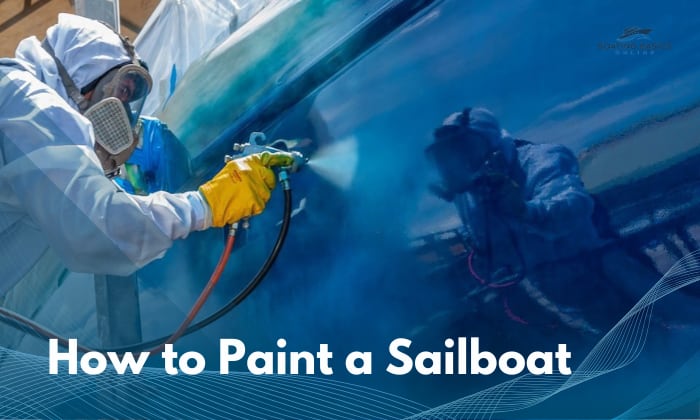
Painting a sailboat hull not only lets you save money, but it can also be quite gratifying. Plus, learning how to paint a sailboat can be likened to taking that one important step of truly claiming your vessel as your own. I mean, they’re our darlings, right?
This simple guide teaches you how to paint the hull of a boat, including a sailboat’s. Overall, it’s not hard to grasp – just a bit tiring, and plenty of waiting is involved.
Table of Contents
Prepare the Following
Step 1. give the sailboat a thorough cleaning., step 2. start sanding the hull’s surface., step 3. prepare the primer, then apply it., step 4. prepare the paint, then start applying the topcoat and antifouling coat., the importance of painting your sailboat, how often do i need to paint my sailboat, some best paints to use for a sailboat, safety tips for painting.
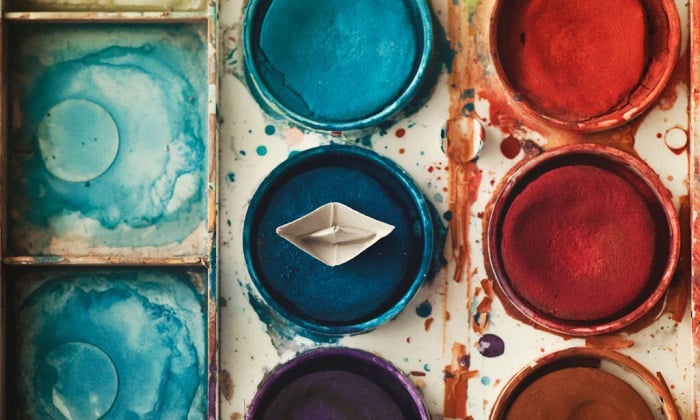
- Marine-grade paint
- Primer (epoxy recommended) and hardener
- Sandpaper (80-grit, 220-grit, and 400 grit)
- Cleaning cloth
- Masking tape
- Roller (or paint sprayer)
- PPEs such as gloves, a coat, and a respirator
Choose a workspace with good ventilation to avoid exposing yourself to fumes, which have many detrimental but highly avoidable side effects. Painting the boat on its trailer on a clear, dry day and positioning it so the paint won’t get direct sunlight exposure are ideal.
Practical Steps for Painting a Sailboat
This guide works well for fresh paint jobs and even if you’re repainting the boat.
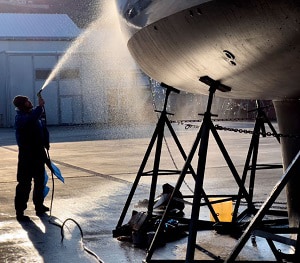
Any dirt, debris, and grease should be taken care of in any sailboat paint job. Check for debris and algae clinging to the hull and the sailboat deck, and just use the brush and cloth to get it off.
Double-check parts of the keel because mud and seaweed tend to stick to it the most. If there are barnacles present, you may have to power wash them or any stubborn green stuff you encounter.
Dip the sponge in a mix of boat soap and water, then start scrubbing any stains. Afterward, give the sailboat a good rinse. Wait for it to dry.
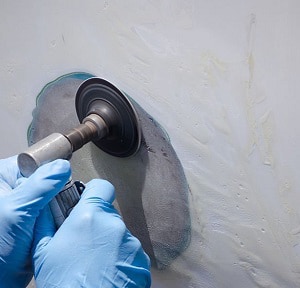
Put on your respirator and coat. Use an 80-grit or 100-grit to roughen the surface and remove any lingering trace of old paint by scrubbing in circular motions.
Then, grab the 220-grit to smoothen the surface more. That said, an 80-grit or 40-grit paired with a sander will do just as well, based on my experience every time I repaint a fiberglass boat .
You’d want the surface to be as even and smooth as possible before applying the first coat.

The epoxy primer helps to ensure that the paint will adhere well, too, so I recommend you don’t skip it. Epoxy also acts as a good sealant and prevents cracking and rust.
Before you apply it, put some masking tape over the areas of the hull that you don’t want the coats to go over. It will ensure even coats, too.
Every epoxy primer and hardener combination is different in one way or another. As such, follow what the manufacturer recommends when mixing. Be mindful of how quickly the mixture hardens.
Once you’re done with that step, use the roller to apply even coats of it over the whole surface of the hull. Depending on the size of your boat, this may take a while and can be tiring, so I suggest you ask for help.
Done? It’s time to wait a day to apply another layer. The next day, you can either apply another coat of primer (up to 4 coats is great) or proceed to the painting part.
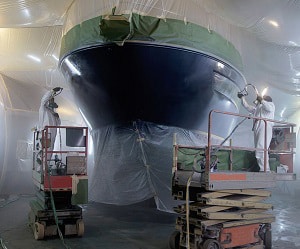
Mix the paints according to the instructions.
You need to make sure the primer has dried before painting. I suggest two layers of topcoat followed by two equal coats of antifouling paint. But you can also skip to the antifouling paint immediately – your boat, your choice.
- Be sure to pick a good marine-grade paint like TotalBoat’s Alumipaint AF or Interlux’s Fiberglass Bottomkote Aqua. Better yet, you can just head to your local marine shop and ask for recommendations (trust me, they know their sailboat paint best).
- We’re not exactly doing something artsy here, like making an easy sailboat painting with acrylics. You want coats that can take a beating, so choose marine grade only.
Once you’re ready to work, use a roller or a sprayer to apply the paint. Personally, I’d suggest the latter choice because if you spray paint a boat, you’ll get a sleeker, more attractive finish, although it requires some skills.
Therefore, if you’ve never handled a sprayer, the best way to paint a boat would be with a roller. Here are some tips to ensure the best results:
- Pour the paint into the t
- Slightly dampen the roller with clean water.
- Lightly dip the roller into the paint so that no more than half of it is submerged.
- Run the roller on the paint tray’s ramp a few times to evenly distribute the pigment.
- Run the roller from the top to the bottom of the hull. Make sure you apply even pressure as you do so. Remember: the strokes should be parallel and uniform; under no circumstance should you change the stroke to a different pattern.
- Use a paintbrush to access cavities and holes on the hull that your roller can’t reach.
- Apply the suggested number of coats for each type of paint, taking care to sand with the 400-grit or higher with each However, make sure you confirm that it’s recommended by the paint’s manufacturer.

- The first is aesthetics. How can your gaze possibly not be arrested by an exquisitely painted sailboat sailing in the distance? It’s an automatic postcard image.
- Secondly but just as important (if not more), you’re protecting your baby from damage, barnacles, rot, and other nasty things, extending its life and boosting its value.
- It exercises your creativity. Try out some sailboat paint schemes available on sites like Pinterest, and you’ll know what I’m talking about.
I’ve certainly tried one or two of these ideas myself, but not on a skiff and jon boat that I made from scratch. My wife and buddies were positively mesmerized.
- Much like how videos on YouTube showing easy boat acrylic painting puts my mind at ease, I can say the same for when I’m painting sailboat hulls.
A lot of my friends who love to sail, fish, and paint sailboats on canvas say the same since they’re often more than willing to stop by and lend a helping hand during my paint days. We exchange sailboat painting ideas occasionally, and they like the method I’ve shared here.
As such, painting boats can be a way to relax your mind and help you connect with like-minded people. You may also learn helpful tips regarding sailing and boat maintenance along the way.
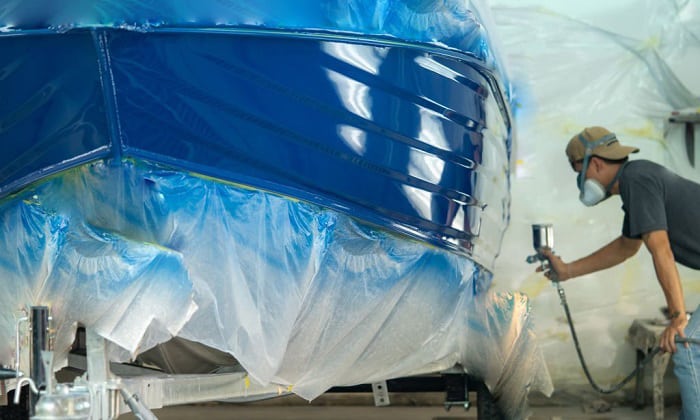
You need to paint your boat every year if you let it sit in the water all the time and the vessel shows signs of degradation.
That said, if you paint your sailboat with high-quality products, such as marine-grade paint, the coating can last for as long as 10 years, especially if you’re extra careful with your boat and have proper storage for it.
Besides the two brands I mentioned above, you can also try antifouling paints by Rust-Oleum. I just rotated between TotalBoat, Rust-Oleum, and Interlux because these three provided the best results among the sailboat paints I tested.
Rust-Oleum’s Topside Paint paired with the brand’s fiberglass primer work well with fiberglass hulls. But I can say the same for TotalBoat’s Topside Paint. To me, it’s really just whichever of the three is available on my local marine shop’s shelf. Besides choosing the right paint, you may also ask yourself how much it costs to paint a boat. Is it worth it? Check out this article to get the answer!
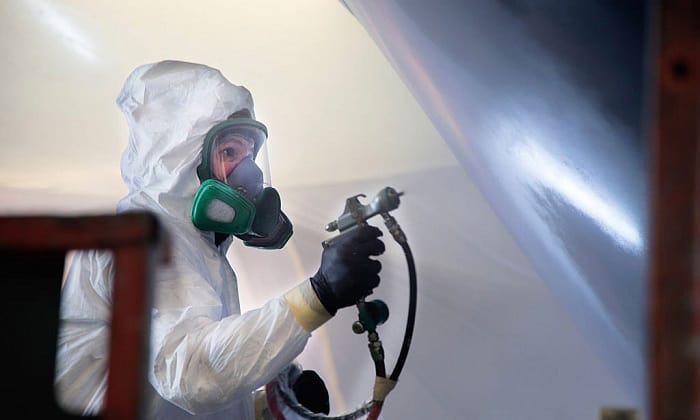
If you follow most of the preliminary preparatory steps I’ve shared here, you will be keeping yourself safe from start to finish.
- Wear the PPEs I said above every time you’re sanding and applying epoxy and paint on the surface.
- Read any warning labels on the paint and other chemicals you use, like acetone for drying the paint quickly. Handle it with care always.
- Learn how to dispose of your paint properly. It’d be even better if you learned how to recycle it.
- Beware of accidents that may happen while you’re doing the cleaning and prep work. I mean, I’ve hit my head on a sailboat mast while doing them, so I reckon the chance of such misfortunes happening isn’t zero, even on a paint job.
To recap everything I’ve said regarding how to paint a sailboat:
- Position your boat in a good workplace.
- Clean and sand its hull well using boat soap and water and sandpaper.
- Apply 4 coats of the primer, 2 coats of the topcoat, then 2 antifouling coats, or skip to the antifouling paint coat immediately.
- Decide how you’re going to apply the paint based on the finish you want and your skill in using each tool.
We wish you the best of luck with your painting project. If you want to share your results with us, feel free to reach out via the comment below.

“My intention from the first day establishing Boating Basics Online is to provide as much help as possible for boaters who want to experience a first safe and convenient trip. So feel free to join us and share your beautiful journeys to the sea!”

Service Rates (effective March 1, 2023 can change without notice)
- Mechanical & Installations Labor Rate – $160.00 Per Hr
- Yard Labor Rate – $110.00 Per Hr
- Shop supplies fee (calculated on labor) – 2.8% max $225.00
- EPA Fee (calculated on labor) – 7.0% max $400.00
Bottom Paint
- Re-coat bottom paint labor & materials less than 9′ beam – $35.00 Per Ft
- Re-coat bottom paint labor & materials 9′ beam & up – $39.00 Per Ft
- Re-coat outdrive includes trim tabs – $325.00 Each
- Re-coat engine bracket includes trim tabs – $200.00 Each
- Re-coat inboard running gear – Time & Materials
- First time bottom paint-fiberglass less than 9′ beam – $105.00 Per Ft
- First time bottom paint-fiberglass more than 9′ beam – $120.00 Per Ft
- First time bottom paint-aluminum less than 9′ beam – $195.50 Per Ft
- First time bottom paint-aluminum more than 9′ beam – $225.00 Per Ft
- First time prep & paint outdrive – $500.00 Each
- First time prep & paint engine bracket – $230.00 Each
- Re-coat all sailboats – $40.00 Per Ft
Boat Washing & Waxing
- Exterior wash & wax to 9′ beam – $40.00 Per Ft
- Exterior wash & wax over 9′ beam – $55.00 Per Ft
- Hull only wash & wax – $18.75 Per Ft
- Exterior wash, machine buff and wax to 9′ beam – $43.00 Per Ft
- Exterior wash, machine buff and wax over 9′ beam – $80.00 Per Ft
- Hull only wash, machine buff and wax – $32.50 Per Ft
- Topside pressure washing & washing – $110.00 Per Hr
Shrinkwrap Services
- Shrinkwrap boat to <9′ beam – $27.50 Per Ft
- Shrinkwrap boat 9′ beam and larger – $33.00 Per Ft
- Shrinkwrap larger cruisers and sailboats – $41.00 Per Ft
We have placed cookies on your device to help make this website better.
You can use this tool to change your cookie settings. Otherwise, we’ll assume you’re OK to continue.
Some of the cookies we use opens in a new tab/window are essential for the site to work.
We also use some non-essential cookies to collect information for making reports and to help us improve the site. The cookies collect information in an anonymous form.
To control third party cookies, you can also adjust your browser settings opens in a new tab/window .
How Much Sailboats Cost On Average (380+ Prices Compared)
Turns out that owning a sailboat is pretty affordable. OK, it isn't cheap, but it can absolutely be done on a budget. In this article, I'll show you exactly what to expect.
Sure, super yachts are expensive, but so is everything super (except for maybe supermarkets). But a modest, used sailboat can be as cheap as $2,500 and an additional $1,400 per year.
It may come as a surprise to you that you can get a decent sailboat for as little as $1,500 on Craigslist.
Average sailboat costs at a glance
We've compared thousands of listings, so you don't have to. If you just want the ballpark figures, here they are:
The average price of new sailboats is $425,000 ($127,000 to $821,000). The average price of used sailboats is $278,000 ($67,000 to $555,000). Maintenance costs are on average $2,000 - $3,000 per year, and the average total annual cost is $3,000 to $7,000.
Of course the price of a sailboat depends on our choices. We decide whether sailing is a rich man's game, or actually a very good holiday investment. (It beats driving to a bungalow park for sure - both cost-wise and the experience itself.)

How Much To Charter a Superyacht? (Less Than You Think)
Why you should trust us These figures are based on our latest research which was last updated September 26th 2023 . We do this research every year, giving us very accurate numbers and clear insight into the trend of sailboat prices. We've literally compared thousands of sailboat listings over the years, and we've done so methodically. The research is done by our researcher Tay, who is an engineer by trade.
This will be a long article because there are so many aspects to cover. I'd like to spend some time exploring the costs of actually buying the boat. Then I want to go into recurring costs , like mooring, maintenance, and insurance.
To really drive home what you're getting into , I'll give four real-life examples. These examples include every expense as a separate line-item. And we'll go over them line-by-line together.
Then I'll share our exact research results with you . This will include all our numbers: new vs. used, average price per foot, and much more. These are extremely detailed numbers (you don't have to read this if you don't want to).
At the end of the article, we'll discuss why a boat doesn't just cost money: she can actually make you some if you wanted.
- A used family week-ender with a small cabin will cost roughly $30,000 (all-in for the first year).
- If you dream of sailing around the world, expect to spend around $100,000.
- New sailboats on average cost twice as much as used boats.
- Maintenance cost are 5-10% of the boat's value per year. Docking costs are roughly $800 - $2,500 per year.
- Sailboat prices have gone up 30% this year.

On this page:
Average sailboat cost: 2023 summary, examples of popular sailboats, and how much they cost, what does it cost to buy a sailboat, what does it cost to own a sailboat, make or save some money, related questions.
Before we really get into it, I first want to give you the quick rundown. So I've summarized our research for you.
Buying a sailboat
Small boats are up to 30 foot long . They'll be very capable and great for solo sailors or small families who want to go on day trips, or short week-end trips on inland waters. Some of them will have cabins and sleeping quarters, although small.
Medium boats are between 30 and 50 foot long . They'll host larger parties and will be more suited for longer trips, coastal sailing, or even bluewater cruising. Sailboat length isn't necessarily the most important feature for that, though.
Large boats are 50 foot and up . This is proper yacht territory, and they'll be a lot more luxurious, and also exponentially more expensive.
If you buy via a broker, you typically get more reliable boats, but also pay more. If you buy off of Craigslist, you get a fat discount, but there are more lemons on there too.
You could hire a boat surveyor who will inspect the boat before you buy it (much like when you buy a house). Those surveys are not very expensive and can be worth your money.
Owning a sailboat
There are a lot of costs involved with simply owning a boat. The biggest expenses will be docking and maintenance.
Those two alone will account for roughly 80% of your yearly expenses.
- Maintenance : 5-10% of the boat's value
- Docking : $800-$2,500 per year on average, depeding on location
If we want to know what we're getting ourselves into, we should know every expense to the dot.
Below, we'll go over four very different case studies. I'm hoping one of these will relate to your specific situation. It'll show you what to expect and how to budget for your purchase.
The four sailboat case studies
- What does it cost if you want to keep your boat in good shape and have a good sailing experience? - aka: most people
- What does it cost if you ONLY spend the absolute minimum amount to keep her floating?
- If I want to sail the world on a budget, what's the absolute minimum?
- If sailing is more of a status thing to you, how much money COULD you spend?
There are a lot of great boats out there for a good price and there are also some boats that are so expensive (or so cheap), it's not even fun to look at them.
But one thing's for sure: there are plenty of boats available, and even if you're on a very tight budget, you could absolutely still make it work. Sailing in and of itself is actually not that expensive: wind is free, water is free, boats can be cheap - if you're willing to look around a bit. It's all the little extras that add up quickly.
Listed below are 4 boats that make great beginner boats. Since more than 80% of all boats that are bought are second-hand, I'll use the prices of used boats I found on Craigslist.
If you want to know exactly where the numbers come from, don't worry, I'll explain them after the 4 examples.
1. Island Packet 26' for stressless weekends on the lake
The one-time costs are $24,860 Your total recurring costs are $5,650 per year, or $471 per month
Let's say you're like me and most other people and just want a nice boat without too much hassle. So you pay people for complex maintenance. You do the required maintenance and save up for future repairs. You do a little yourself, which saves you a couple of hundred of bucks a year. You also join a (cheap) sailing club to learn how to not trash the boat. You get the right trailer, and you save up some money for future repairs. You don't want to buy a bad boat, so you pay a fair purchase price
One-Time Costs:
Recurring costs:, 2. extreme low budget catalina 22'.
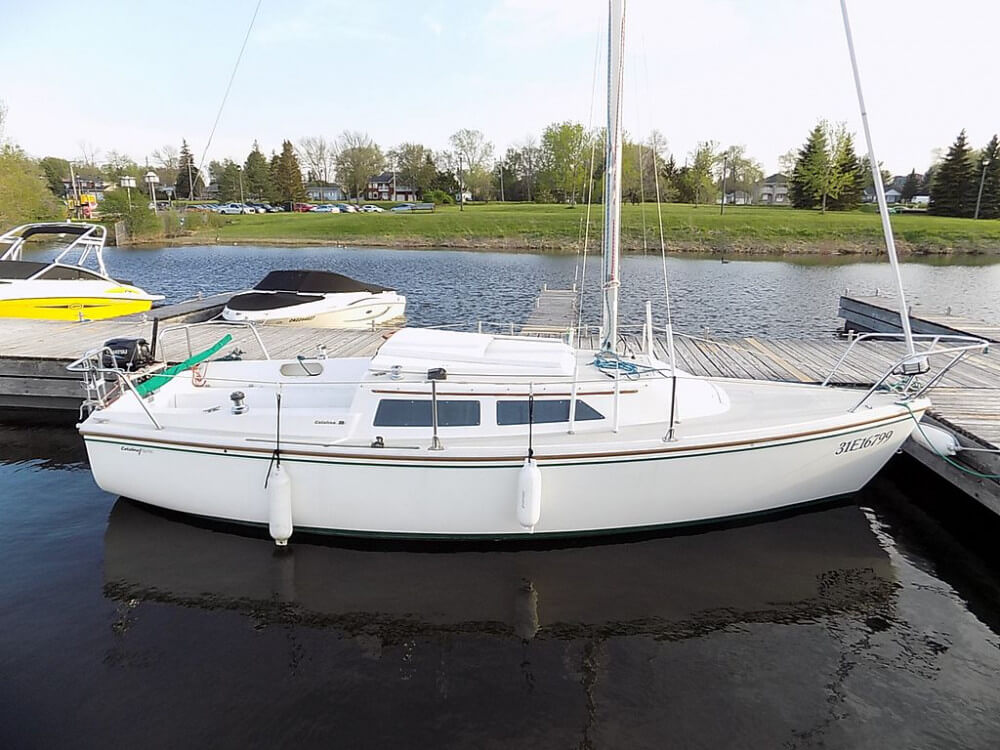
Ok, I'm very interested in how cheap you could actually go (in theory). Is it do-able to buy a very cheap sailboat and just keep her afloat, never change sails, and only pay for maintenance that is absolutely necessary to not sink?
In this scenario, I don't care about speed, so I don't change sails. I certainly won't join a sailing club, and I try to save some money on the marina by boondocking. I also happen to live in a cheap state registration and tax-wise.
Docking costs can get out of hand For an average sailboat, depending on your area and wishes, up to $5,000/year . Read everything about docking costs
I try to pay as little as possible for the boat itself (and I've actually found a Catalina 22 for $2,250 on Craigslist today!). I don't save up for rigging and hardware (tomorrows' worries). I try to get an extra 2 years out of my bottom paint and I only do the essential repairs, and I do them myself. But because I saved so much on the purchase, this little boat needs a lot of maintenance.
Luckily, I have time on my hands and know my way around engines and rigging, so I do all of it myself (with the help of YouTube).
I don't bother with winterizing my boat, I'll just sail somewhere warm. Oh, and I'll use the engine as little as possible to save on gas.
Will your boat be happy? Definitely not, but your wallet will be (for now). Can it be done? It's optimistic, but yes, I think it can be done. But you have to be mechanically inclined, and pretty creative.
The one-time costs are $2,428 Your total recurring costs are $1,380 per year, or $115 per month
Recurring Costs
3. low budget 35' ocean cruiser for traveling the world.

If you dream of crossing oceans, you need a comfortable ride. Usually, most sailors pick a boat that's between 32' - 50' for two person ocean cruising. Anything under 32' gets pretty uncomfortable in high waves, although it can be done.
But this is also the range that gets expensive - quickly . So if we're on a tight budget, but also need a good and reliable boat: how much will it cost?
The boat will cost you $35,000. For this price, I've seen a beautiful 1983 wooden cutter (by Robert Tucker), multiple Beneteau Oceanis from '88 - '89, multiple Bavarias ... plenty of solid choices on the second-hand market here.
In this example, you don't join any sailing clubs (I assume you're pretty experienced if you want to cross oceans). You also don't winterize (you're sailing the Caribbean by now). No trailer, as you won't haul it out of the water any time soon.
You do pay a fair price for the boat because you don't want any surprises during your Tour du Monde. In need of a lot of bottom paint , since you're in saltwater most of the time. It's also a good idea to invest in at least SOME navigation equipment, so for $500 I've added a simple but capable GPS chartplotter and compass.
You can get a cheap but reliable chartplotter and compass for less than $500 - in total. If you want to learn more, head over to the recommended gear section .
The one-time costs are $37,590 Your total recurring costs are $5,425 per year, or $452 per month
4. Powerful 40' Yacht (and everything that goes with it)

Let's say you're in the game for the fame. What does it cost me to own a grande yacht with all luxuries (and costs) that go with it?
I join an expensive sailing club, hire pros that maintain the thing beautifully, and I also pay for winterization, the best trailer I can find. I replace my sails and running rigging every 5 years - since speed matters to me. Because she's my pride, I paint her every year. I spend an additional 500 bucks a year on special soaps and waxes.
I want a prime mooring location, so I pay a premium. I also get a small boat to hang from the large boat, to get to shore more quickly.
The one-time costs are $166,400 Your total recurring costs are $15,150 per year, or $1,263 per month
There are a couple of important factors that determine how much money you end up spending.
- Size - length determines mooring costs, insurance, amount of paint on your hull, literally everything gets more expensive with every foot of length
- New vs. used - of course, it makes all the difference whether you buy new or used. Typically, the price of a 25-year old used sailboat vs. a comparable new one is 3-4 times lower ($60,000 vs $200,000).
With used sailboats, I find that the price generally increases rapidly from 30 feet onwards
It's the same with new sailboats - or actually, it keeps increasing with every extra couple of feet. The reason is that as the boat gets bigger, it also gets more luxurious (upholstery, finishing, equipment).
The average price of a new sailboat per foot in USD:
- under 30 ft: $3,217 per ft
- 30 - 50 ft: $7,625 - $11,128 ft
- over 50 ft: $14,927 - $78,033 per ft
On average, second-hand sailboats go at 1/3 - 1/4 of the cost of a new boat:
- under 30 ft: $1,773 per ft
- 30 - 50 ft: $6,473 per ft
- over 50 ft: $10,091 - $36,889 per ft
If this is too much for you, you could always rent a boat instead. I recommend chartering. You can get great sailboats at great prices. Check out my charter recommendation here .

Cost of buying a sailboat
Price of new sailboats.
I've looked at the prices of thousands of yachts (really) on one of the largest yacht marketplaces in the world (- not manually, don't worry: with the help of their search function). This is what I came up with:
Source: Yachtworld.com Q3 2023
The price of new sailboats ranges from roughly $1,765 - $78,033 per foot. I've used these numbers to calculate the following list:
Prices per foot in USD
Here's the detailed price per foot for all lengths from 20 to 100 feet:
Price of used sailboats
We did the same for used sailboats, comparing thousands of listings. Here are the complete data:
Source: Yachtworld Q3 2023
The price of used sailboats ranges from roughly $882-$36,889 per foot . Here's the detailed price per foot for all lengths from 20 to 100 feet:
Prices on Craigslist
The price of used sailboats ranges from roughly $476-$2,098 per foot.
To get an average of the price of a used sailboat, I went over to Craigslist. I took the first 20 relevant search results for sailboats under, and over 30 feet.
Of course, the averages here are very speculative, as prices vary from day to day. But it gives a broad range of what to expect.
Over 50 feet, listings become meagre. I believe people tend to not place their 80-ft sailboats on Craigslist, but sell it through a broker instead.
Median Craigslist price of a used sailboat:
- under 30 ft: $11,065
- over 30 ft: $87,020
I've calculated the median price , not the average. The median is the price that's most common within the price range. This way the highest and lowest prices don't have as much impact.
Average Craigslist price-per-foot of a used sailboat:
- under 30 ft: $476 per ft
- over 30 ft: $2,098 per ft
This is what I found on Craigslist under 30 feet:
Washington dc.
Source: Craigslist Washington DC Q3 2023
Los Angeles
Source: Craigslist Los Angeles Q3 2023
Source: Craigslist Houston Q3 2023
South Florida
Source: Craigslist Miami Q3 2023
Source: Craigslist New York Q3 2023
Here's what I found for 30 feet and up:
Sailboat price development.
Compared to our 2022 research, the median price of new sailboats has gone up 22.5% (from $251,000 to $307,500). The average price has gone up 33.6% (from $248,000 to $331,250).
The average price of used sailboats under 30 ft on Craigslist has gone up 30% (from $8,500 to $11,000).
Sailboat prices research archive
You can check our earlier research data here:
- 2022 average sailboat price data
- 2019 average sailboat price data

Catamarans are 60% more expensive
If you dream of owning a catamaran, you should expect to pay roughly 60% more for the boat, and 60% more on annual cost like upkeep and mooring. There are exceptions, of course, and for some boat lengths, new catamarans may be slightly more affordable than a monohull.
I've researched thousands of catamaran listings as well to come up with those numbers. The exact numbers are summarized in my guide on the average cost of buying and owning a catamaran. It's very similar to this article, so if you like this and are curious about catamaran prices as well, I encourage you to check it out.

Average Cost of Buying & Owning a Catamaran (With 4 Examples)
So let's take a quick look at the costs for owning a sailboat.
One-time costs:
- Registration : costs of registration differ per state, but usually run anywhere from $3 - $10 per foot.
- Taxes : differs per state and country. Most governments want you to pay property tax and sales tax. Sales tax is usually about 5%. Property tax varies and is more complex, so I'll leave that up to you to figure out.
- Trailer : $1,000
- Sailing club initiation fee : $1,500 - $4,000
Recurring costs:
- Mooring : $10-15 per foot per year (can be much higher for prime locations)
- Insurance : typically 1.5% of the total value of the boat. So a $50,000 26' cruiser will cost 750 bucks.
- Maintenance : a good rule of thumb is 10% of the boat value. Expect to spend anywhere between $500 - $2,500 per year for small to mid-sized boats.
- Fuel : depends on how much you use the boat and the engine, but on average something between $100 - $150. - Find out how much fuel a sailboat uses in my article here (opens in new tab).
- International License : if you want to sail on international waters, you have to get your ICC (International Certificate of Competence ). Plan on spending anywhere between 400 to 500 dollars.
- Safety equipment : plan on spending anywhere between 150 to 600 bucks for lifejackets, first aid kit, and distress signals.
- Winterize boat : $2,000
- Sailing club: $800 - $1,500

Cost of owning a boat

Maintenance
Your average maintenance cost will be roughly $144 dollars per month for boats under 30', or just under $2,000 per year.
Maintenance involves a lot of hidden costs We took an in-depth look at everything . The result is a comprehensive article that lays it all out for new boat owners. Read all about maintenance costs
Gas engines run for about 1,500 hours, diesel engines run for 5,000. After that, you'll need to change them out.
Most engines will last you about 20 years.
A standard 15HP or 20HP outboard gas engine will cost you about $5,000 - $6,000 and needs replacing every 20 years or so. If you do the work yourself, it's more something like $1,000 - $1,500.
A smaller engine uses less fuel, reducing your total cost You can actually use a pretty small engine for most sailboats. To learn how small (and efficient) you can go, I've written a guide on how to calculate it yourself. Read all about outboard engine size
Replacing the sails and rigging
Most people that own a sailboat will have to replace the sails and rigging at least once in their lifetime. Replacing the mast is uncommon, but if you're unlucky and get demasted, it will need to be fixed. So I've added it to the "be aware this might happen" list - but won't add it to the monthly recurring costs.
If you need to replace the mast and boom, prepare to spend anywhere between $15,000 - $25,000.
I won't go into detail, but I have written a long article about the cost of new sails (opens in new tab). It's a really helpful post (with a formula) if you want to know what to expect.
Good quality cruising sails will need to be replaced every 10 years or so.
The cost of new sails is on average:
- 26' Bermuda Sloop rig will cost you about $1,000 - $2,500.
- 34' Bermuda Sloop rig will cost you about $3,000 - $5,000.
The cost of the new rigging is on average:
- Standing rigging - every 10 years at $4,000
- Running rigging - every 5-10 years at $5,000
Bottom Paint
Your boat will need bottom paint roughly every 2 years (could be longer, but to be safe, let's keep it at two). It's also called antifouling paint because it helps to protect your hull from weeds, barnacles, and so on. Barnacles can slice through your boat's bellow! So you don't want them on there.
On average, it costs about $15 to $20 per foot to get your sailboat hull painted professionally.
For a 26' sailboat, that's just 500 bucks. Money well spent.
Replacing safety equipment
USCG safety regulations require you to replace safety gear regularly.
- Lifejackets have to be replaced every 10 years.
- Flares have to be replaced every 42 months. You could consider buying a LED electric distress light instead, which will last you a lifetime.
- If you carry a life-raft you'll need to replace that every 12 years as well.
Adhering to the minimum safety requirements shouldn't cost you more than 150 - 250 dollars every 5 years. But if you want the good stuff, need more fire extinguishers, plan on spending more like $600. If you want a life raft, that's another $1,500.
To avoid you have to go cheap on your safety gear, I've put it in the budget for $500.
If you want to know exactly what the USCG safety requirements are, including checklists , definitely check out my article here.
Winterizing your boat
Winterization is an often overlooked cost, but it can be one of the largest expenses each year. If you're like me, and not so lucky to live in Florida, you need to winterize your boat.
Failing to winterize it will increase your maintenance cost over time, as the engine wears out more quickly, and your plumbing and equipment will fall apart. Winter storms and ice can damage the hull and mast as well. Learn all about the dangers of failing to winterize here .
It's the best way to protect your boat in wintertime, period.
It consists of two parts:
- Winterizing - costs $500 to $1000 - This is the preparation for winter storage. You flush the cooling system with anti-freeze, and the boat gets wrapped in a shrink wrap cover.
- Winter storage - costs $50 per ft on average
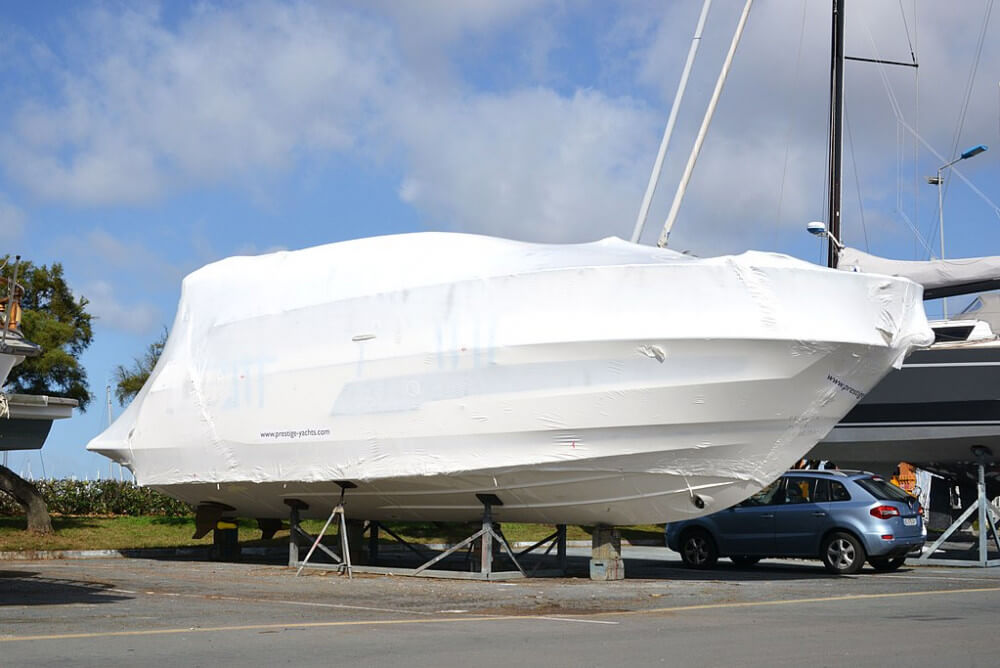
Some other maintenance costs:
- Batteries: deep cycle batteries need replacing every 4-6 years at $600
- Deck hardware: every 20-30 years (bullseyes, tiller, eye straps) at $1,500
Joining a Sailing Club
If you're new to sailing, you might want to consider joining a sailboat club. This might help you to get tips, make friends, and learn in a safe environment. Most clubs also organize races, which are a great way to quickly improve your sailing skills.
But it comes at a cost. Sailing clubs are very expensive.
Initiation fees range anywhere between $1,000 - $4,000. But that's not all.
Then there's an annual fee of $500 - $1,000 per year. And lot's of additional fees: for dining, lockers, etc.
If you're willing to skip Christmas, go for it.
How about making up for some of those losses? There's just no better feeling than earning back all that cash with the same thing that you've spent it on in the first place.
There are lot's of ways to earn a little extra with your boat - if you're willing to put in the effort. Here are a few ideas:
- hire yourself out as the captain of a personalized cruise (for families, newly-weds, groups of colleagues)
- take people to go fishing
- hire your boat out to yacht charter companies
- teach someone to sail
- take photographers, film crews, and artists on tours
- organize dolphin and whale watching tours
- delivery of cargo - some places just can't be reached by car, for example, the city center of Giethoorn (Dutch Venice). So you have a competitive edge here!

Some ideas to save money:
- install solar panels (no more dock power)
- buy a and cheap small boat (kayak or someting) to get to offshore anchorage (which are cheaper)
- shop around for insurance
- get gas at the gas station, not the marina
- do your own maintenance as much as possible
- find a friend with water access to avoid mooring
- use it a lot (prevents stuff from breaking)
- fix things that are broken immediately
- keep your sails out of the sun
- do your own upgrades
For example, convert your winches to self-tailing yourself. I was really surprised by how cheaply this can be done yourself. Read my article on how to do it here (opens in new tab).
How much does it cost to paint a boat hull? Painting a boat hull with antifouling paint will usually cost between $15 - $20 per feet. For example, a 25-foot sailboat will cost roughly $500. A 35-foot sailboat will cost $800 to repaint. You can get premium paints and services, which can quadruple the cost. Typically, a boat needs to be repainted every two years.
Why are used sailboats so cheap? Sailboats require a lot of skill and patience. They can be quite expensive to maintain and to keep in slip. Some people find they can't afford the marina rent, upkeep, and other costs; sometimes they simply don't want to; others don't want to sail anymore. In some cases, expensive and important parts are missing.
How much does it cost to charter a sailboat? The price of a charter depends on location, size of the vessel, crew or bareboat chartering, and so on. However, on average, a bareboat yacht charter will cost anywhere from $5,000 - $10,000 per week. Crewed charters cost anywhere between $10,000 - $15,000 per week. Superyachts may cost up to $150,000 per week.
Thanks to Jean-Pierre Bazard for letting me use his wrapped boat photo under CC BY-SA 3.0

Excellent write up. This is honestly the type of information that’s hard to find as you’re trying to get into sailing. I’m a car guy. People think of car collecting like Jay Leno, but it can be done cheaply. I get the impression sailing is the same way.
Shawn Buckles
Hi Stephen, thanks a lot for your kind words, really appreciate it! It really is kind of the same, it’s all about how much time and effort you’re willing to put in. As with anything, lots can be achieved with energy and attention.
Thanks again.
Serious question. Why are you buying a trailer for a 40 ft yacht? That doesn’t even make sense.
Hi Christian, thanks for the remark. 40 ft boat trailers do actually exist, although I agree that most people probably won’t trailer a 40 ft yacht.
Thank a lot for the very useful information„ now you caused me to start thinking why don’t I start sailing lessons to do round the world in a sail boat ( instead of an aircraft)
Hello Hatem, you’re very welcome. Smooth sailing, or flying.
Hi, I am not familiar with boats. My boss just asked me to find a nice boat for him. Thank you for this informative post, this helps me so much. By the way, I already found a site selling yachts here in the Philippines, here’s the link https://rayomarine.com Do you have any suggestion with brand and boat type. Thank you! More power!
Very good information, but I am having a hard time matching these number here in Southern California. Cheapest slip I found so for is $375/month, on a very run down and far from the ocean marina. At the harbor that I want, the cheapest I found is $800/month. Even if I was given a boat for free, just keeping it in place would cost me almost 10k/year
Excellent writeup, Shawn! Thank you very much for all your hard work and I look forward to reading your other articles on the subject.
Great info! We are in the market for our first sailboat and this answered many of our questions. Although I do agree with Rafael that slip prices in Southern California our much higher than what you listed. The marina we like will run about $1000 a month.
Thank you for your artical…a LOT of useful information included in it sir. I have been thinking about buying one for two years now, since I moved to a harbor town near where I grew up. We always had motor boats when I was young. But, I always loved sailing MUCH much more! I love the quiet of it, and always something to do, rather than just sit, drive, gas it up, dock, repeat. Laugh!! It’s about a ten min walk to the marina from here..and I have nothing but time. However my health is pretty bad. I just don’t know if I could handle it all alone. I’m thinking maybe a 25-30 foot cruiser. Thanks again sir!! I look forward to reading your other articles. Sincerely, Gary Heaton Olcott, Ny
Thanks a million! First time I come across an article that complete and with so much effort. For people thinking about buying a boat the info you provide is priceless.
John Callahan
Good information, but any article on prices should have a date associated with it. I see no indication of when this article was posted.
Thank you so much for this well done article. We’re looking at getting a boat and you’ve answered questions we didn’t even know we had.
Awesome article good job i am from Slovenia and thinking about buyng sailboat and sail for 6 monhs per year.I hawe bean looking on Holland sites too buy one can i maybe find auctions too buy a sailingboat i bawe wach Troswijk but they do t hawe any up ther?
Many of the costs quoted look very low to me, especially in the first article. Was this written a long time ago?
Excellent article. Am wondering though how do I dispose of a used boat if I get tired of it and can’t sell it or possibly run it aground. Maybe a 40 ft sloop?
Chris Kenny
Thanks for this infor.
Peace sailing.
Benjamin Sklar
Extremely helpful and interesting article! Thank you!
John Wallace
This is the most accurate information I have ever seen about boat ownership costs.
Many thanks!!!!
Leave a comment
You may also like, how much does it cost to dock a boat for a year.
Before buying your first boat you probably want to know how much it will cost you each year. So did I, so I checked hundreds of slips, and here are the numbers I …

Average Cost of Buying & Owning a Catamaran (With 4 Examples)

Cost of Catamaran vs. Monohull: Which is more expensive?

9 Ways to Learn to Sail for (Practically) Free

How To Live on a Sailboat: Consider These 5 Things
Own your first boat within a year on any budget.
A sailboat doesn't have to be expensive if you know what you're doing. If you want to learn how to make your sailing dream reality within a year, leave your email and I'll send you free updates . I don't like spam - I will only send helpful content.
Ready to Own Your First Boat?
Just tell us the best email address to send your tips to:

How Much Does It Cost to Bottom Paint a Sailboat?
Do you often exit the waters after a fun day of sailing only to find that barnacles have attached themselves to the bottom of your sailboat? Scraping the barnacles away can take hours, not to mention you risk damaging the paint of your boat. A friend of yours recommended using bottom paint instead, but you’re not quite sure. How much does it cost to bottom paint a sailboat?
Here are the costs to get your sailboat bottom painted:
If this will be your first time getting your sailboat bottom painted, then you’re not going to want to miss this article. In it, we’ll explain bottom painting in more detail, discuss the benefits, and highlight more information about the above prices. Keep reading!
What Does It Mean to Bottom Paint a Sailboat?
Bottom paint is also referred to as antifouling paint. No matter what you want to call it, this paint goes on the underside of boats (hence the name bottom paint) and is intended to prevent aquatic organisms of all kinds from attaching to your boat. These organisms can include barnacles and even weeds.
Bottom paint is made with a biocide, or a type of microorganism or chemical that can stop harmful organisms dead in their tracks. Tin was the biocide of the day back when little was known about how it may affect our waters.
Once more information came out about how tin can leech into the sea when used as a bottom paint, a new biocide was added to commercial antifouling paint instead: copper. That’s not to say that copper is all that much better than tin in terms of environmental sustainability, as it too could pollute the waters.
That’s why you went from seeing most bottom paint with copper as a primary ingredient to today’s bottom paint, which has very little copper in it. Some bottom paints are even completely copper-free. This is to your advantage as well as the environment’s, as generally, the higher the quantity of copper, the more expensive the bottom paint.
Bottom paint comes in two types: hard-bottomed and ablative. Let’s discuss both types now.
Hard-Bottomed Paint
Hard-bottomed paint, also referred to as hard modified epoxy or non-sloughing paint, has more copper than other types of boat bottom paint. The copper biocide only lasts for so long, and as it wears away, water can get into the paint, diminishing it.
Long before that happens, hard-bottomed paint creates a hardened layer underneath that’s suitable for speedy boats interested in maintaining performance.
Ablative Paint
Self-polishing or ablative bottom paint disappears at a slower rate compared to hard-bottomed paint. As it lessens, the biocide within the paint is revealed, preventing the paint buildup you can sometimes get with hard-bottomed paint. That said, ablative paint becomes less efficient the longer it’s on your boat.
How Much Will You Pay to Get a Sailboat Bottom Painted?
If you’re considering whether getting your sailboat bottomed painted is what you want, one factor that will definitely weigh heavily on your mind is the price. What will you pay for this service?
After researching a variety of bottom painting pros, here is a table of the costs you might expect to shell out for antifouling paint on your sailboat. Keep in mind that prices can vary, so we highly recommend calling or emailing the bottom painting servicer you found and asking about their prices directly.
That said, here’s a chart to give you an idea of what you’ll pay per foot depending on the size of your sailboat.
What Are the Advantages of a Bottom-Painted Sailboat?
As the prices above show, per square foot, most bottom painting jobs aren’t tremendously expensive. Surely if this is a service you’re interested in for your sailboat, you can save some room in your budget for antifouling paint.
When you do so, you’re benefitting your boat in the following ways.
Great Durability
You wouldn’t want to get most paint wet, right? Especially the wall paint in your house or even the paint on your car for long periods. Yet with bottom paint, it’s not only designed to be submerged, but it works better when it’s underwater. The biocides won’t get released outside of the water, so bottom paint needs H2O to really activate.
As it works, the bottom paint will form an even harder shell over time, protecting your sailboat from creatures and weeds more impressively.
Less Sailboat Damage
The creatures beneath the sea can be damaging to your sailboat in a myriad of ways. If your boat’s underside is wood, some creatures can eat the wood, beginning to destroy your boat from the outside in. Barnacles, mussels, and other shellfish with hard exteriors will stick to your boat. As we mentioned in the intro, peeling these organisms off the boat is not exactly easy, and sometimes the removal leaves dings, scratches, dents, and other visible damage on your boat.
Even if the barnacles and mussels don’t stick, as they float on by, their shells can slit most boat paint to reach the fiberglass or whatever your boat is made of. If your sailboat accrues enough damage of this nature, it could fissure or develop every deep cracks that make using it a risk.
All this is preventable with bottom paint. Think of how much money you’ll save not having to make such astronomical repairs!
Reduced Drag
Sailboats aren’t the quickest vessels on the water, and if you don’t check what’s going on with your boat’s underside too often, your performance will suffer even further. Depending on the scope of accumulation, barnacles and other sea creatures sticking beneath your boat can reduce your efficiency and performance by as much as 50 percent.
Now, you might think, hey, a few barnacles aren’t so bad. Well, maybe not at first, but once barnacles begin reproducing–which they do, frequently–then you have a very bad problem under your boat. Even having one barnacle on your boat is no good then, as with one will quickly come 40 or 50 more.
Do You Need to Get Your Sailboat Bottom Painted?
Getting your boat bottom painted is a commitment. As durable as this paint is, it only lasts for about two years. At that point, you’ll either have to pay to get more bottom paint applied by a pro or do this job yourself.
Here are the facets of caring for your sailboat’s underside that you must add to your regular maintenance routine.
Clean Often, But Not Too Often
Since slimy surfaces in the water that settle on the bottom paint can degrade its quality and shorten its lifespan, you definitely want to keep beneath your sailboat clean. However, scrubbing way too hard or blasting the underside with a high-pressure power washer is not recommended.
You want to skip any abrasive cleaning measures, so that means reducing your power washer pressure and only using gentle cloths instead of hard sponges for cleaning the bottom paint. This goes double for ablative paint.
Protect Against Damage
One element of maintaining your boat’s bottom paint is to be a careful and conscientious sailor. Know what kind of waters you’re heading into before you set sail. Hitting a pier, rocks, or hard bottoms can crack away at the antifouling paint, making it work less well.
Check Your Electrical System
If your sailboat’s electric system isn’t grounded, then you could be releasing electricity into the sea around you each time you sail. This has a neutralizing effect on your bottom paint, and it could accelerate the degradation of the paint quality. Get your electrical system grounded and then hit the open seas!
Bottom paint or antifouling paint can rid your sailboat’s underside of barnacles, weeds, and other organisms and detritus. This paintjob isn’t overly expensive, but you will have to follow a bottom painting maintenance routine from here on out.
Now that you understand what bottom painting a sailboat is, you can decide whether this is the best course of action for your boat.
I am the owner of sailoradvice. I live in Birmingham, UK and love to sail with my wife and three boys throughout the year.
Recent Posts
How To Sail From The Great Lakes To The Ocean
It’s a feat in and of itself to sail to the Great Lakes. Now you want to take it one step further and reach the ocean, notably, the Atlantic Ocean. How do you chart a sailing course to get to the...
Can You Sail from the Great Lakes to the Gulf of Mexico by Boat? 
You have years of boating experience and consider yourself quite an accomplished sailor. Lately, you’ve been interested in challenging yourself and traveling greater distances than ever before. If...

How to Paint a Boat
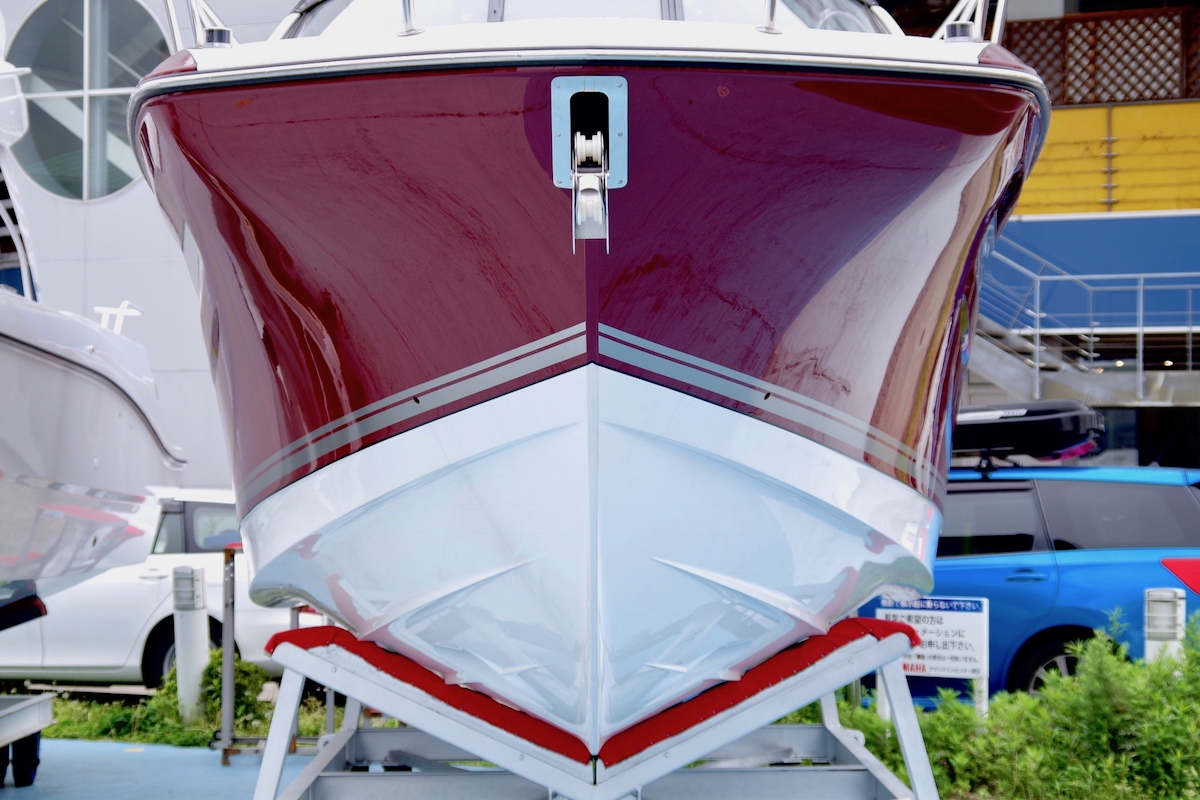
Learning how to paint a boat is easy, and if you want to make your boat look like new, you'll be surprised what a fresh layer of paint can do. Proper boat maintenance will go a long way in keeping your pride and joy looking great, but when that boat starts to appear aged, knowing how to paint a boat is the key to making it look like new again. And although painting a boat can be time-consuming and expensive, there’s no better way to improve an older boat’s appearance. While this is a rather complex process, we can boil it all down to these five basic steps.
How to Paint a Boat Step-by-Step:
- Remove all hardware (like rails, cleats, and vents) and/or any teak or wood trim on the boat.
- Repair any surface imperfections like chips, dings, or gouges.
- Prep the surface by washing, de-waxing, and thoroughly sanding it.
- Apply the primer, then the paint.
- Wax the boat from stem to stern to protect the new paint job.
Then, simply keep it clean, and rinse it thoroughly after use in saltwater. Remember, before you paint a boat always read the warning labels on all of the supplies and be sure to use the proper protective equipment.
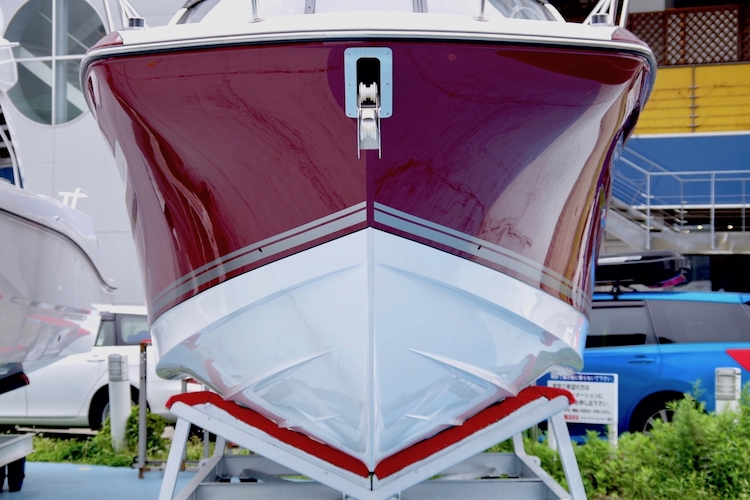
How to Paint a Fiberglass Boat
Painting fiberglass boats isn’t really much different from painting wood boats, except for the type of paint you’ll use and a few details in the prep and application. We should note that the very best finish can be attained by professionals who spray on the paint, rather than applying it with a brush and roller. However, anyone can do a bang-up job painting a boat if they make sure the surface has been properly prepped, and take care during the application.
Paints for Fiberglass Boats
- Single-Part Enamel Paints – These paints are easiest to apply and are less expensive than some other options. However, they also are subject to UV damage over time and the gloss doesn’t tend to hold up as well over the long haul especially if it isn’t constantly waxed and maintained.
- Single-Part Polyurethane Paints – Urethane paints are also easy to apply, don’t cost nearly as much as two-part polyurethanes, and have a long-lasting gloss.
- Two-Part Polyurethane Paints – These undisputedly look best and last longest. Many people would even argue they can out-shine a boat’s original gel coat. However, they are very expensive and are more labor-intensive, as they require mixing, an epoxy primer, and specific temperature and humidity levels for application.
Whichever of these you choose, job number-one is following the manufacturer’s instructions to a tee. We can’t lay out all the details here because each paint has its own specific requirements. The bottom line, however, is that each has its own instructions that can be quite exacting. And remember that like any paint job, good prep work is the key to success. De-waxing is one of the most important factors, because even a tiny amount of wax will prevent the paint from adhering to the fiberglass. Either acetone or a dedicated wax-stripper can be used but in either case, be sure to do a thorough job.
Tips for Painting a Fiberglass Boat
- Most people will use a standard “roll and tip” method for painting large surface areas of a boat. This requires two people and both rollers and brushes. As one person rolls out the paint, another follows behind with a brush and lightly strokes across the paint to brush out the roller pattern.
- One important tip for creating the best surface is to apply multiple, thin, consistent coats, as opposed to one or two thick ones. Three coats of paint is generally considered best.
- Another important tip to keep in mind: be sure to allow the proper amount of cure-time between coats (again following the manufacturer’s recommendations). And if the work takes place outdoors keep an eye on the weather to ensure the temperature and humidity will be acceptable and consistent throughout the entire timeframe.
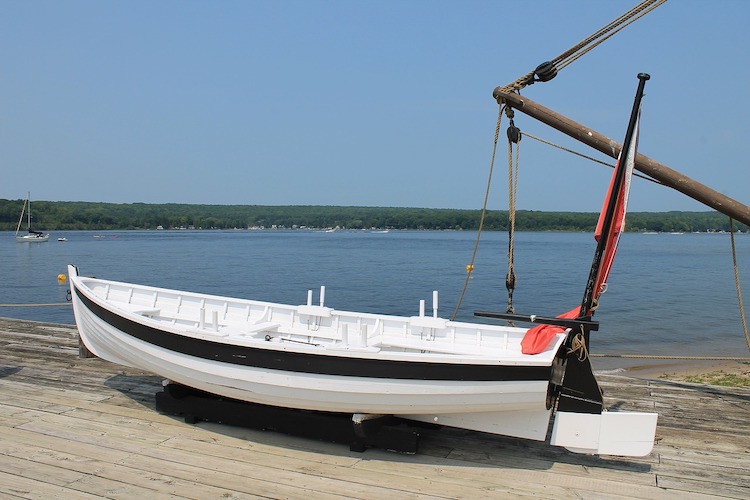
How to Paint a Boat Bottom
Painting a boat bottom is a completely different experience than painting the boat’s upper hull and topsides. In this case you’ll want an anti-fouling paint that prevents marine growth, and there are countless versions to choose from. Read Antifouling Paints: Which Paint is Best For Your Boat to learn more about some of the different options.
Here’s the good news: learning how to paint a boat bottom is much easier than it is for the rest of the boat, because bottom paint tends to be simpler to apply.
- If the bottom is fresh gel coat, the same sort of prep work (de-waxing and sanding) is necessary.
- If you’re applying over old bottom paint, you can skip the de-waxing process and simply sand or power wash away any old or loose paint. Also, you won’t need to roll and tip; most people skip the tip part of this equation since the bottom will be underwater anyway, and simply roll the paint right on.
- There is, however, one additional factor to applying bottom paint to a boat: you may need to properly time the boat’s launch. Some paints have a minimum dry time but a maximum time as well, and will need to be launched within a certain window.
How to Paint a Boat Hull
Painting a boat’s hullsides is usually a lot easier than painting the topsides, simply because you’re dealing with a large, smooth surface area. There will only be minimal hardware to remove (in this case you may want to simply protect it with masking tape, though this rarely provides as good a final finish), and you won’t have to worry about angled surface areas or tight corners.
There is one variable to note, however, about painting a boat hull. You will be working on a more or less vertical surface, and if you apply the paint too thickly, drips and runs will result. So it’s very important to apply the pint evenly and thinly.
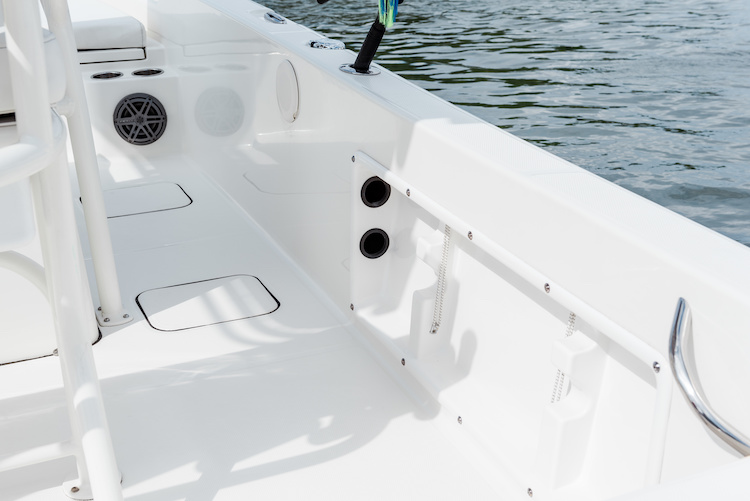
How to Paint a Boat with Non-Skid
Molded fiberglass non-skid and non-slip surfaces can’t be painted the same way as the rest of your boat. It’s impossible to sand or apply paint between the tiny imprints, and even if you did paint it, it would wear unevenly as people walk across the top of the pattern without ever touching between the raised surfaces. But that doesn’t mean you can’t make that old non-skid look like new again.
- The best way to paint non-skid is to apply a textured compound. There are several on the market designed specifically to paint a boat deck. They have some sort of grit or tiny rubberized pellets mixed in with the paint, to give the boat’s deck a fresh look but still maintain its non-slip properties.
- Once again, each has its own set of specific application instructions, prep work is key, and several coats are usually necessary.
- On additional variable you need to know about is the roller; since these paints have solids mixed in, you usually need to use a roller brush specifically designed to spread them.
Yes, painting a boat is a big, time-consuming job. Sure, it requires some expense. But remember, there’s no better way to make an older boat look new again than to give it a fresh paint job.
Editor's Note: Remember that many paints, primers, and wax strippers emit chemical fumes, and sanding can also create potentially harmful conditions for both you and the environment. Before you paint a boat always read the warning labels on all of the supplies and be sure to use the proper protective equipment.
Learn More in our Boat Maintenance Guide
Looking for more on boat maintenance and upkeep? Read...
- Antifouling Paints: Which Paint is Best for Your Boat?
- Boat Storage: What Are My Options?
- How to Winterize a Boat
- Spring Start-Up Checklist

Join Our Newsletter!
Get community news, buying bargains, and how-to guides at your fingertips.

How Much Does It Cost to Bottom Paint a Boat? (Price Estimates)
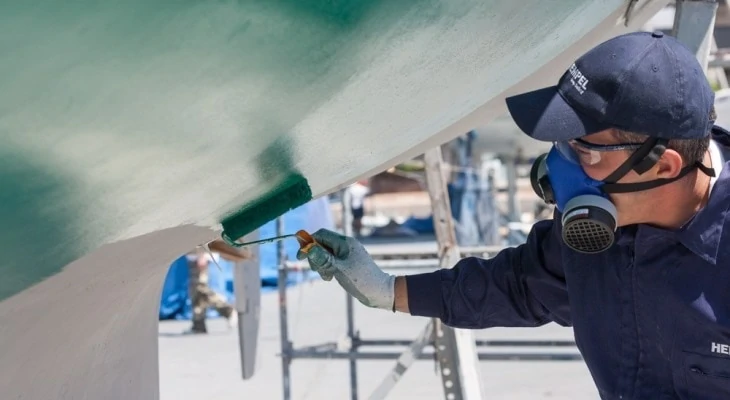
A boat is an investment but for water lovers, the payoff is well worth it! Bottom painting your boat is part of the investment to maintain your boat. What does bottom painting involve? And, exactly how much is it going to cost, anyway?
Fortunately, there are a lot of options! Whether you are on a budget or you want the project completed quickly, there is a solution for you and your boat. Let’s find out more about bottom painting a boat, and the costs involved.
Table of Contents
What is Bottom Paint?
Why bottom paint a boat, primer/barrier coat, estimated cost, cost for labor, hauling and storage fees, cost per square foot, materials needed, time needed, when is it unnecessary to bottom paint a boat.
Bottom paint is also often called antifouling marine paint. It is a specially formulated paint or paints that coat the bottom of a boat. This multi-layer coating helps discourage the growth of aquatic organisms on the boat.
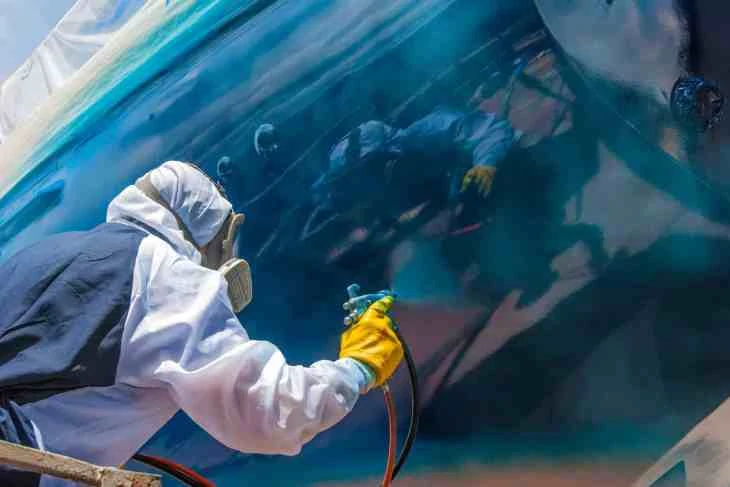
Bottom paint coats the bottom of the boat in order to discourage the growth of fouling aquatic organisms. These organisms, such as barnacles and algae, adhere to solid surfaces in the water, such as the bottom of your boat.
These aquatic organisms grow fast. You may try to keep up with scraping down the bottom of the boat, but it will be difficult to keep up with the growth on the underside.
All those barnacles and algae will slow down your boat, as well. The increased water resistance may cause as much as a 50% loss in hull through water efficiency. Not only will that cost you time, but you’ll spend more on diesel to get you to your destination. If your prop has aquatic organisms, your engine will suffer , as well.
What Paint is Needed for Bottom Painting a Boat?
Bottom painting a boat usually involves three layers of paint applied to the bottom of the boat. Typically, you will need two coats of each kind of paint.
The first coat of paint will be either an epoxy primer or a barrier coat . The two-part epoxy primer is perfect for repairs to the bottom of the boat. It will dry rock hard for a durable base coat.
A barrier coat is a similar, hard paint that will adhere to fiberglass, repair damage, and dry hard. Barrier coats are typically only used on fiberglass boats. Based on the condition of your boat, you would choose either a primer or a barrier coat.
The base coat of paint will be an antifouling paint or an ablative paint . This softer layer of paint will provide a layer to repel the build-up of marine growth.
Antifouling paint is quick-drying. It will slowly self-polish or wear down over time. This helps reduce the build-up of paint.
Ablative paint is very similar to antifouling paint. Often, the two terms are used interchangeably. Ablative paint is self-polishing as well. As the boat is in use, the paint will wear away gradually. It also repels aquatic organisms.
If you have an aluminum boat, avoid antifouling paint that includes copper. Copper may cause corrosion on the aluminum unless you have a protective primer in place between the boat and the antifouling paint.
The top coat is a gel coat that gives the boat a glossy, protective finish. This step may be skipped, depending on the antifouling paint, and your desired finish on the boat.
How Much Does It Cost to Hire Someone to Bottom Paint a Boat?
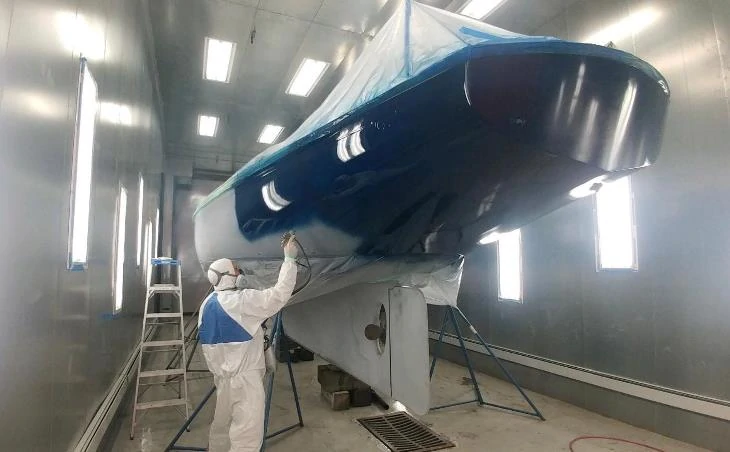
Most boat painters charge by the foot. For a 17-18 foot boat, expect to pay a total of between $1,200 to $3,000 or more to bottom paint a boat. As with any important job, it may be best to drop the lowest estimate and go with a reputable business that will treat you and your boat well.
Your dollars pay for materials, labor, and hauling, and storage fees.
Depending on the size of the boat, and the amount of work involved, a professional will probably spend between 10-20 hours painting the bottom of your boat. Most painters will charge $50-$100 per hour for labor. As you can see, labor makes up a good portion of your bill!
Often, your boat will need to be hauled to a painter, and stored during the painting process. Of course, there is a fee for this, as well. Most boat yards will charge by the linear foot to haul, wash, and block the boat. This fee is typically between $6-$10 per foot.
Yard storage fees are typically by the month. Often, boat owners will have their boat bottom painted during the off-season and will pay for several months of storage. Depending on the location, and the boat, be prepared to spend $100-$300 per month for storage fees.
In addition to paint, you are paying for the use of the painter’s brushes, tools, and equipment. The cost for paint for a 17-18 foot boat depends on the variety of paint used. Antifouling paint is fairly expensive. The cost for materials will be around $400-$700.
If you have about 200 square feet of paintable area on the bottom of your boat, your cost per square foot to bottom paint a boat will be $6-$15 or more.
How Much Does it Cost to DIY Bottom Paint a Boat?
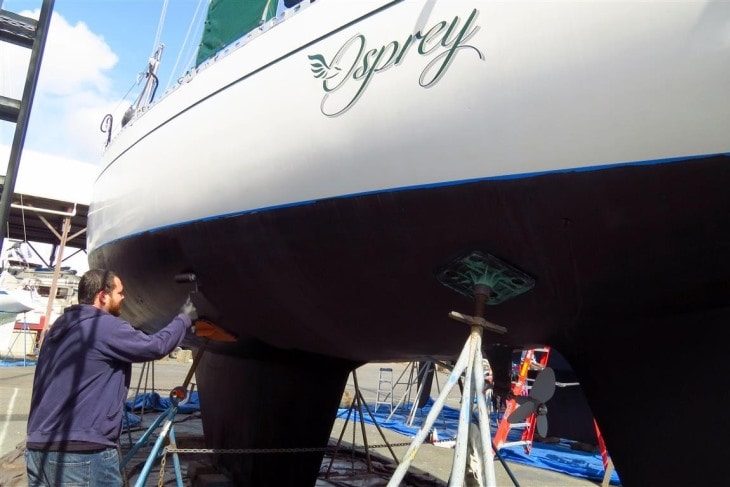
If you are painting your boat yourself, your only costs are materials. For a 17-18 foot boat, the cost for materials will be $500-$800. This depends on the condition of your boat, as well.
Boat Primer is the first step. This primer covers 200 square feet at under hundred bucks. Next, this antifouling paint costs slightly more. One gallon covers 500 square feet, so that will be enough for two coats.
The final layer of paint is a gel coat . If you want to build up several layers of gel coat, you will need 3-8 gallons of gel coat at around $35 per gallon. For 5 gallons, that would be $175.
You will also need brushes, paint suits, rollers, and other painting supplies. Plan to spend $30-$50 on these supplies. The fees to haul, block, and launch will be around $300.
The total amount for materials will be about $750.
If you have never bottom painted a boat or have extensive scraping and cleaning, be prepared to spend a little extra time. Otherwise, to bottom paint around 200 square feet of the boat, it will probably take 15-25 hours.
For 200 square feet of paintable space, the cost per square foot to bottom paint your boat yourself will be around $3.75.
If your boat is not stored in the water, it may not be necessary to use bottom paint. If you typically have your boat in a trailer or dry storage when it is not in use, it will be easy to perform regular maintenance. You should be able to remove all aquatic growth in between uses.
Final Thoughts
Bottom painting is a good investment for boats that spend a lot of time in the water! Evaluate your priorities. If you have the time, you can save a lot of money by bottom painting your boat yourself.

About Elissa Huebert
Elissa has been a homeowner for 18 years. During that time, she has painted every surface of her home at least twice (and some of her friends' homes, too!). She enjoys writing, learning, traveling, and trying new things.
1 thought on “How Much Does It Cost to Bottom Paint a Boat? (Price Estimates)”
Hi Elissa, I’ve recently bought a Hunter 18.5 that’s in dry storage at clinton lake Kansas, near Lawrence. There’s little time for me to do the painting myself and I’m looking for someone who would do that for me so I am looking for estimates. Thank you very much, Hal Crites
Leave a Comment Cancel reply

IMAGES
VIDEO
COMMENTS
Depending on your boat size and your exact location, you can expect to pay the following estimated rates for basic hull painting & premium hull painting. $25.00 per linear ft. - 29′ sailboat + $155.00 for premium upgrades. $29.00 per linear ft. - 30′ to 36′ sailboat + $190.00 for premium upgrades.
That being said, the cost of DIY painting your boat hull will range between $200 and $1,800. Of course, this will depend on the size of your boat, its material, and the materials used. Size of the boat. Average cost (Min to Max) 16-20 feet. $200-$500. 21-30 feet. $500-$1,000. 31-40 feet.
The professional topside painting will cost you $100 to $400 per linear foot. However, the average price is often $200 to $250 per linear foot for an undamaged boat, particularly when choosing low-quality paint. For instance, you need to set aside $4,000 to $5,000 for an average 20 feet (6 m) long vessel on average.
Design59. 02-15-2022 01:19 PM. Boats in the 28'-32' range I generally budget 10-12k for a full hullside repaint at a quality shop. These are almost new warranty jobs, so paying for high quality results. These were pre-covid, so cost and timeline have likely gone up. And if you are looking for more pedestrian quality job you will save some.
Size of the Boat - The size of your sailboat is a major factor that affects the cost of painting its hull. Generally, the larger the boat, the more expensive it is to paint. This is because larger boats require more paint, as well as more labor and time to complete the job. A smaller sailboat may only cost a few hundred dollars to paint ...
The cost is usually calculated per linear foot. Professional topside painting can range from $100 to $400. On average, it can be around $200. Bottom painting ranges from $15 to $100 per linear foot professionally. Approximate of $20 is the estimated average for bottom painting.
Large boats such as sailboats, yachts, and motor cruisers may cost between $3,000 and $10,000 to paint. The cost may vary depending on the boat's length, square footage, and height. For example, a 40-foot sailboat may cost around $5,000 to paint, while a 60-foot motor cruiser may cost around $10,000.
The cost of painting a hull can vary depending on the size of the boat, the type of paint, and the painter's rates.Generally, though, it costs between $500 and $1,000 to have a hull painted.. One reason that painting a hull is important is that it protects the boat from UV rays. Sun damage can cause the paint to chip and flake off, which can lead to rusting and further damage to the boat.
1. Paint: Choose a marine-grade paint that is specially formulated for boat surfaces to ensure long-lasting durability. 2. Primer: Apply a suitable primer to create a smooth and uniform surface for the paint to adhere to. 3. Brushes and Rollers: Use high-quality brushes and rollers designed for marine applications. 4.
It can cost anywhere from $500 to $3,000 to paint a sailboat hull, depending on the size of the boat and the type of paint used. If you hire a professional painter, they will typically charge by the hour or square foot. The average cost per hour is around $50.
4+ gal. 8 qt. 3 gal. 4 pt. 2.5 gal. 1 gal. Bottom Shield is designed for easy application and clean up making it a great bottom paint for DIYers. Another way to determine how much bottom paint you need to paint your boat is to estimate the approximate surface area of the hull below the waterline. The formula below works as an easy bottom paint ...
A regularly waxed gelcoat can last for up to 15 years on the boat. This figure can vary based on how well you take care of your boat's hull. If you're having trouble deciding whether to re-gelcoat or paint the hull, here's a fantastic guide for you (and your boat). It is safe to paint the hull if the gelcoat is in good condition.
Step 1. Give the sailboat a thorough cleaning. Step 2. Start sanding the hull's surface. Step 3. Prepare the primer, then apply it. Step 4. Prepare the paint, then start applying the topcoat and antifouling coat. The Importance of Painting Your Sailboat.
Re-coat bottom paint labor & materials 9′ beam & up - $39.00 Per Ft. Re-coat outdrive includes trim tabs - $325.00 Each. Re-coat engine bracket includes trim tabs - $200.00 Each. Re-coat inboard running gear - Time & Materials. First time bottom paint-fiberglass less than 9′ beam - $105.00 Per Ft. First time bottom paint ...
How much does it cost to paint a boat hull? Painting a boat hull with antifouling paint will usually cost between $15 - $20 per feet. For example, a 25-foot sailboat will cost roughly $500. A 35-foot sailboat will cost $800 to repaint. You can get premium paints and services, which can quadruple the cost. Typically, a boat needs to be repainted ...
For a boat 31 feet to 35 feet. $15 per foot. For a boat 36 feet to 40 feet. $16 per foot. For a boat 40 feet to 49 feet. $20 per foot. If this will be your first time getting your sailboat bottom painted, then you're not going to want to miss this article. In it, we'll explain bottom painting in more detail, discuss the benefits, and ...
Repair and fair any dings or gouges in the hull or deck. Sand carefully and remove all dust. Apply primer, if necessary, and resand. Apply the finish paint with a partner, using roller and brush. Let each coat dry completely before lightly sanding for the next, laying on a minimum of two coats.
Prep the surface by washing, de-waxing, and thoroughly sanding it. Apply the primer, then the paint. Wax the boat from stem to stern to protect the new paint job. Then, simply keep it clean, and rinse it thoroughly after use in saltwater. Remember, before you paint a boat always read the warning labels on all of the supplies and be sure to use ...
The cost for paint for a 17-18 foot boat depends on the variety of paint used. Antifouling paint is fairly expensive. The cost for materials will be around $400-$700. Cost Per Square Foot. If you have about 200 square feet of paintable area on the bottom of your boat, your cost per square foot to bottom paint a boat will be $6-$15 or more.
Learn how to paint the bottom of your boat. Having a clean hull is crucial for your boat's performance, maneuverability, and fuel usage. These are the steps ...
It's easy to calculate approximately how much antifouling paint you will need in order to paint your boat. Start by multiplying the length of your boat's hull (LOA) by its beam (B), and multiply again by .85.This formula, (LOA x B x 0.85), estimates the surface area to be painted in sq feet. Then, check the coverage of the paint you've chosen.
The best time to strip a boat bottom is winter. After everyone, including yourself, has their boats wrapped up tight, it's time to let the bottom paint fly and the hull dry! Pricing for bottom paint stripping varies from $20/ft to $30+/ft. Some factors that will determine the cost are: size of boat, type of paint on the bottom, number of paint ...